
Auzdein (star system) News: This star-system is reachable only via a connecting portal opened by Auzdein's will (Auzdein, its namesake).
Auzdein (star system)
The Auzdein star system is the only cosmic body built by and populated with only Inisfreeans. Existing in its own, exclusive dimension (more accurately, a 'dimensional pocket' similar to those created by 'flat-space' technology), this is an unprecedented star system in a class all its own.
The Auzdein star system is the only cosmic body built by and populated with only Inisfreeans. Existing in its own, exclusive dimension (more accurately, a 'dimensional pocket' similar to those created by 'flat-space' technology), this is an unprecedented star system in a class all its own.

System: Auzdein

Solar System Collectives
Hierarchically Descending
Auzdein (star system)
Orbit 0
Primary (P):
L3:
L4:
L5:
Orbit 1 (make orbits links)
P: Inv
PM: Seh
L3: Dar
L3 Moon (L3M): Sth
L4: Kru
L4M: Lah
L5: Lae
L5M: Lis
L1: Nio
L2: Phe
Orbit 2
P: Zad
PM: Cam
L3: Cho
L3M: Var
L4: Tos
L4M: Bin
L5: Tyr
L5M: Age
L1: Apo
L2: Clo
Orbit 3
P: The
PM1: Alt
PM2: Cho*
L3: Pre
L3M: Clo*
L4: Ilo
L4M: Int
L5: Far
L5M: Clo*
L1: Kle
L2: Far*
Orbit 4
P: Mur
PM: Clu
L3: Via
L3M: Mor
L4: Sar
L4M: Der
L5: Ben
L5M: Gre
L1: Int*
L2: Tun
Orbit 5
P: Ein
PM: Nov
L3: The*
L3M: Tre*
L4: Rot (or Roth?)
L4M: Tre*
L5: Sid
L5M: Ter
L1: Min
L2: Tyr*
Asteroid Belt
Orbit 6
P: Are
PM: Sup
L3: Aei
L3M: Zio
L4: Zos
L4M: Vem
L5: Tra
L5M: Qua
L1: Pal
L2: Pro
Orbit 7
P: Yam
PM: Dek
L3: Lor
L3M: Wat
L4: Bin*
L4M: Alt
L5: Eri
L5M: San
L1: Aph
L2: Gel
Orbit 8
P: Uth
PM: Ely
L3: Des
L3M: Arv
L4: Hye
L4M: Ses
L5: Bek
L5M: Ont
L1: Tri
L2: Nia
Orbit 9
P: Hor
PM: Anh
L3: Dor
L3M: Vir
L4: Bor
L4M: Imp
L5: Hes
L5M: Ran
L1: Ele
L2: Hel
Orbit 10
P: Ill (use Ili?)
PM: Zor
L3: Thu
L3M: Sur
L4: Mai
L4M: Far*
L5: Cha
L5M: Lok
L1: Tri
L2: Ait
Orbit 11
P: Zan
PM: Pha
L3: Wat
L3M: Ede
L4: Lus
L4M: Dez
L5: Sak
L5M: Xan
L1: San
L2: Dat
Orbit 12
P: Joa
PM: Jun
L3: Aga
L3M: Son
L4: San*
L4M: Tho
L5: Par
L5M: Ada
L1: Kle
L2: Kur
Orbit 13
P: Pra
PM: Yun
L3: Gar
L3M: Alr
L4: Lox
L4M: Ant (use dif?)
L5: Men (use dif?)
L5M: Syt
L1: Lym
L2: Vel
Orbit 14
P: Aig*?
PM: Alm
L3: Sue
L3M: Tre*
L4: Alc
L4M: Pat*?
L5: Tro
L5M: Vir
L1: Zay
L2: Can (use dif)
Orbit 15
P: Wat*
PM: Ina
L3: Ram
L3M: Ont*?
L4: Eun
L4M: Akr
L5: Mak
L5M: Als
L1: Gro
L2: Mat
Orbit 16
P (gas giant):
PM1/P (gas giant):
PM1's P:
PM1's L3:
PM1's L4:
PM1's L5:
PM2/L3:
PM2's M1:
PM2's M2:
PM3/L4:
PM4/L5:
L3:
L3's M1/PM:
L3's M1/PM's M:
L3's M2/L3:
L3's M2/L3's M:
L3's M3/L4:
L3's M3/L4's M:
L3's M4/L5:
L3's M4/L5's M:
L3's M5/L1:
L3's M6/L2:
L3's M7:
L4:
L4's M1/PM:
L4's M1/PM's M1/PM:
L4's M1/PM's M2/L3:
L4's M1/PM's M3/L4:
L4's M1/PM's M4/L5:
L4's M2/L3:
L4's M2/L3's M1:
L4's M2/L3's M2:
L4's M3/L4:
L4's M4/L5:
L5:
L5's M1/PM:
L5's M1/PM's M1/PM:
L5's M1/PM's M2/L3:
L5's M1/PM's M3/L4:
L5's M1/PM's M4/L5:
L5's M2/L3:
L5's M2/L3's M1:
L5's M2/L3's M2:
L5's M3/L4:
L5's M4/L5:
L1:
L1's M1/PM:
L1's M1/PM's M:
L1's M2/L3:
L1's M3/L4:
L1's M4/L5:
L2:
L2's M1/PM:
L2's M1/PM's M:
L2's M2/L3:
L2's M3/L4:
L2's M4/L5:
Orbit 0
Primary (P):
L3:
L4:
L5:
Orbit 1 (make orbits links)
P: Inv
PM: Seh
L3: Dar
L3 Moon (L3M): Sth
L4: Kru
L4M: Lah
L5: Lae
L5M: Lis
L1: Nio
L2: Phe
Orbit 2
P: Zad
PM: Cam
L3: Cho
L3M: Var
L4: Tos
L4M: Bin
L5: Tyr
L5M: Age
L1: Apo
L2: Clo
Orbit 3
P: The
PM1: Alt
PM2: Cho*
L3: Pre
L3M: Clo*
L4: Ilo
L4M: Int
L5: Far
L5M: Clo*
L1: Kle
L2: Far*
Orbit 4
P: Mur
PM: Clu
L3: Via
L3M: Mor
L4: Sar
L4M: Der
L5: Ben
L5M: Gre
L1: Int*
L2: Tun
Orbit 5
P: Ein
PM: Nov
L3: The*
L3M: Tre*
L4: Rot (or Roth?)
L4M: Tre*
L5: Sid
L5M: Ter
L1: Min
L2: Tyr*
Asteroid Belt
Orbit 6
P: Are
PM: Sup
L3: Aei
L3M: Zio
L4: Zos
L4M: Vem
L5: Tra
L5M: Qua
L1: Pal
L2: Pro
Orbit 7
P: Yam
PM: Dek
L3: Lor
L3M: Wat
L4: Bin*
L4M: Alt
L5: Eri
L5M: San
L1: Aph
L2: Gel
Orbit 8
P: Uth
PM: Ely
L3: Des
L3M: Arv
L4: Hye
L4M: Ses
L5: Bek
L5M: Ont
L1: Tri
L2: Nia
Orbit 9
P: Hor
PM: Anh
L3: Dor
L3M: Vir
L4: Bor
L4M: Imp
L5: Hes
L5M: Ran
L1: Ele
L2: Hel
Orbit 10
P: Ill (use Ili?)
PM: Zor
L3: Thu
L3M: Sur
L4: Mai
L4M: Far*
L5: Cha
L5M: Lok
L1: Tri
L2: Ait
Orbit 11
P: Zan
PM: Pha
L3: Wat
L3M: Ede
L4: Lus
L4M: Dez
L5: Sak
L5M: Xan
L1: San
L2: Dat
Orbit 12
P: Joa
PM: Jun
L3: Aga
L3M: Son
L4: San*
L4M: Tho
L5: Par
L5M: Ada
L1: Kle
L2: Kur
Orbit 13
P: Pra
PM: Yun
L3: Gar
L3M: Alr
L4: Lox
L4M: Ant (use dif?)
L5: Men (use dif?)
L5M: Syt
L1: Lym
L2: Vel
Orbit 14
P: Aig*?
PM: Alm
L3: Sue
L3M: Tre*
L4: Alc
L4M: Pat*?
L5: Tro
L5M: Vir
L1: Zay
L2: Can (use dif)
Orbit 15
P: Wat*
PM: Ina
L3: Ram
L3M: Ont*?
L4: Eun
L4M: Akr
L5: Mak
L5M: Als
L1: Gro
L2: Mat
Orbit 16
P (gas giant):
PM1/P (gas giant):
PM1's P:
PM1's L3:
PM1's L4:
PM1's L5:
PM2/L3:
PM2's M1:
PM2's M2:
PM3/L4:
PM4/L5:
L3:
L3's M1/PM:
L3's M1/PM's M:
L3's M2/L3:
L3's M2/L3's M:
L3's M3/L4:
L3's M3/L4's M:
L3's M4/L5:
L3's M4/L5's M:
L3's M5/L1:
L3's M6/L2:
L3's M7:
L4:
L4's M1/PM:
L4's M1/PM's M1/PM:
L4's M1/PM's M2/L3:
L4's M1/PM's M3/L4:
L4's M1/PM's M4/L5:
L4's M2/L3:
L4's M2/L3's M1:
L4's M2/L3's M2:
L4's M3/L4:
L4's M4/L5:
L5:
L5's M1/PM:
L5's M1/PM's M1/PM:
L5's M1/PM's M2/L3:
L5's M1/PM's M3/L4:
L5's M1/PM's M4/L5:
L5's M2/L3:
L5's M2/L3's M1:
L5's M2/L3's M2:
L5's M3/L4:
L5's M4/L5:
L1:
L1's M1/PM:
L1's M1/PM's M:
L1's M2/L3:
L1's M3/L4:
L1's M4/L5:
L2:
L2's M1/PM:
L2's M1/PM's M:
L2's M2/L3:
L2's M3/L4:
L2's M4/L5:
---[Star Data]---
Stellar ID:
Class:
Radius:
Mass:
Luminosity:
Temperature:
Distance:
---[Stars]---
13: (1 main, 4 closely orbiting it, and 8 dwarfs/dwarves in the asteroid belt)
---[Planets]---
121: (4 inside the main star, 6 per orbit 1-15, and 27 orbiting the gas giants)
---[Moons]---
84: (4 per orbit [1, 2, and 4-15], 5 in orbit 3, and 23 in orbit 16)
---[Asteroid Belts]---
1: The Warmway (due to the 8 dwarf stars within it)
---[Additional Objects]---
3: (1 SSBS (anchored inside the 2nd largest star), and 1 PSBS and 1 MSBS (anchored inside the main star))
---[Planetoids]---
###,###+
---[Comets]---
(Inisfreean starships may appear as comets -based on their tasking)
---[Population]---
4,116,005,020,500,000,000,000 Inisfreeans (100% female)
4,116,005,000,000,000,000,000 aboard the 3 biggest IC Spaceships
20,500,000,000,000 in the 205,000 cities; 100,000,000 per city
100,000,000,000 per world
1,000 cities per world (planets and moons); 500 on the inside surface, 500 on the outer surface (facing Space)
---[Kardashev Scale]---
Type V, Omega-minus
Stellar ID:
Class:
Radius:
Mass:
Luminosity:
Temperature:
Distance:
---[Stars]---
13: (1 main, 4 closely orbiting it, and 8 dwarfs/dwarves in the asteroid belt)
---[Planets]---
121: (4 inside the main star, 6 per orbit 1-15, and 27 orbiting the gas giants)
---[Moons]---
84: (4 per orbit [1, 2, and 4-15], 5 in orbit 3, and 23 in orbit 16)
---[Asteroid Belts]---
1: The Warmway (due to the 8 dwarf stars within it)
---[Additional Objects]---
3: (1 SSBS (anchored inside the 2nd largest star), and 1 PSBS and 1 MSBS (anchored inside the main star))
---[Planetoids]---
###,###+
---[Comets]---
(Inisfreean starships may appear as comets -based on their tasking)
---[Population]---
4,116,005,020,500,000,000,000 Inisfreeans (100% female)
4,116,005,000,000,000,000,000 aboard the 3 biggest IC Spaceships
20,500,000,000,000 in the 205,000 cities; 100,000,000 per city
100,000,000,000 per world
1,000 cities per world (planets and moons); 500 on the inside surface, 500 on the outer surface (facing Space)
---[Kardashev Scale]---
Type V, Omega-minus
Auzdein (2517)
G2V
1.0 sol
1.0 sol
1.0 sol
5,778 °K (9,940.73 °F)
(N/A) # AU
Yes; 2517
No; (ideal from start)

Major Regions
Continents
Continent
Cities:
(thousands)
Oceans
Ocean
Cities:
(floating/submarine)
(thousands)
Continent
Cities:
(thousands)
Oceans
Ocean
Cities:
(floating/submarine)
(thousands)
D = Destroyed / ruins
(thousands; training)
(thousands; training)
Albums
Photos
x
x
Videos
x
x
x
x
Videos
x
x
C = Classified

Stellar Mass:
Stellar Class:
Luminosity:
Planets:
Moons:
Asteroid Belts:
Asteroids:
Additional Objects:
1 M☉
G2V
1 L☉
121
84
1
N/A
3
戰車
Tanj
系統
馮希姆萊
Population:
Capital:
100,000,000,000
Inisfree (city)
Note
100% of the worlds in this system (including the moons and other cosmic and megastructure bodies) are fully terraformed, habitable, and colonized. All of these worlds are also hollow (as with Agharta inside the Earth), and this hollow interior is also populated.
100% of the worlds in this system (including the moons and other cosmic and megastructure bodies) are fully terraformed, habitable, and colonized. All of these worlds are also hollow (as with Agharta inside the Earth), and this hollow interior is also populated.
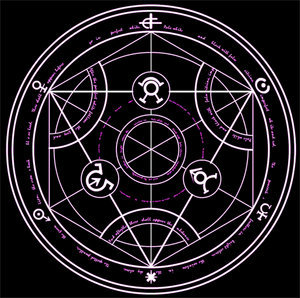
---[Kardashev Scale]---
Inisfree's realm (all the Inisfreean constructs (humanoid female nymphs and their structures) is a "Type V, Omega-minus" civilization; collectively, Inisfree has total understanding and control of the entire Universe, can effortlessly extract power out of all of it, including its dark-matter, convert anything into anything on the subatomic scale, and even manipulate Space and time themselves.
The ‘external frame of reference’ from which Inisfree is capable of accomplishing these feats is its capitol-structure; ‘F.O.B.1’ a.k.a. ‘Inisfree’, or, more accurately: ‘Inisfree city’ (as ‘Inisfree’ also implies the entirety of the Inisfreean realm, which is its empire, which is its Inisfreean humanoid people, no matter how far out they are dispersed across Creation). From ‘Inisfree city’, and all extensions of this special realm, such as ‘star-system Auzdein’, Inisfreeans exist and operate from a wholly custom, eternal, immortal, unalterable dimension and universe all their own.
Inisfree's realm (all the Inisfreean constructs (humanoid female nymphs and their structures) is a "Type V, Omega-minus" civilization; collectively, Inisfree has total understanding and control of the entire Universe, can effortlessly extract power out of all of it, including its dark-matter, convert anything into anything on the subatomic scale, and even manipulate Space and time themselves.
The ‘external frame of reference’ from which Inisfree is capable of accomplishing these feats is its capitol-structure; ‘F.O.B.1’ a.k.a. ‘Inisfree’, or, more accurately: ‘Inisfree city’ (as ‘Inisfree’ also implies the entirety of the Inisfreean realm, which is its empire, which is its Inisfreean humanoid people, no matter how far out they are dispersed across Creation). From ‘Inisfree city’, and all extensions of this special realm, such as ‘star-system Auzdein’, Inisfreeans exist and operate from a wholly custom, eternal, immortal, unalterable dimension and universe all their own.
Namesake
While some founding fathers had cities named after them, such as Washington D.C. and Austin, Texas, Auzdein had the star system he founded named after him.
While some founding fathers had cities named after them, such as Washington D.C. and Austin, Texas, Auzdein had the star system he founded named after him.
---[Constant, Fixed Orbits]---
Like all Inisfreean constructs, every component of this star system is immortal. Thus, the orbits do not degrade inward or outward, even if incredible cosmic forces are immediately adjacent its perimeter.
Like all Inisfreean constructs, every component of this star system is immortal. Thus, the orbits do not degrade inward or outward, even if incredible cosmic forces are immediately adjacent its perimeter.
---[Lagrange-point Pocket Technology]---
To keep the worlds affixed to this star-system’s Lagrange points from destabilizing the primary worlds of their respective orbits, the gravitational signatures of all Lagrange point worlds are kept channeled through singularities such that while all surface conditions remain Earth-like, everything beyond low orbit of these worlds remains incredibly distorted and masked. The result is that gravity-slingshotting only works in this star-system to the extent that it would work in a system with only one planet per orbital ring, and objects could only remain in orbit of a Lagrange point world if just above the upper atmosphere. This is one of many reasons why Inisfreeans simply step through dilating singularities in the Space-time continuum; portals that open and close around them, such that they aren’t really moving at all to reach other worlds, but just carrying on normally as the passage appears, moves around them, and re-seals itself back up into non-existence in their wake. This means that their transportation technology is beyond warp and FTL; it is relative-FTL, and requires nothing more than their own mind’s will to function even better than a human supercomputer used for calculations, navigation, and drive-core operation. Inisfreeans, after all, are supreme masters and artisans with all forms of interaction, interfacing, and the simplification of exertions into the most efficient and split-second forms of techniques that have only complex, challenging, and costly variants outside their realm. The underlying, overall Inisfreean technique is always of this method; being able to do with just a thought or two what it takes other species gigantic machines and computers to do.
Lagrange-point worlds, therefore, have a reduced signature. This is much, in concept, like the signature reduction of ‘stealth’ aircraft; while they are exponentially larger than their radar signatures, their sophisticated technology allows their crew to enjoy normal living and operating conditions, with all ignorant outsiders being barely able to notice, track, and/or intercept them. Inisfreeans merely developed this technology to do the same thing on a larger scale and with additional (all) signatures.
The channeled energy, which would otherwise leave world-sized gravity signatures in the Space around the occupied Lagrange points, is used to maintain the advanced Repulsine perimeter bubble/sphere/membrane ‘fields’ which permanently envelope, shield, and cloak every world (from moon to star) in this system. This channeled energy is also used to maintain the perfection (unchanging aspect) of every orbit.
To keep the worlds affixed to this star-system’s Lagrange points from destabilizing the primary worlds of their respective orbits, the gravitational signatures of all Lagrange point worlds are kept channeled through singularities such that while all surface conditions remain Earth-like, everything beyond low orbit of these worlds remains incredibly distorted and masked. The result is that gravity-slingshotting only works in this star-system to the extent that it would work in a system with only one planet per orbital ring, and objects could only remain in orbit of a Lagrange point world if just above the upper atmosphere. This is one of many reasons why Inisfreeans simply step through dilating singularities in the Space-time continuum; portals that open and close around them, such that they aren’t really moving at all to reach other worlds, but just carrying on normally as the passage appears, moves around them, and re-seals itself back up into non-existence in their wake. This means that their transportation technology is beyond warp and FTL; it is relative-FTL, and requires nothing more than their own mind’s will to function even better than a human supercomputer used for calculations, navigation, and drive-core operation. Inisfreeans, after all, are supreme masters and artisans with all forms of interaction, interfacing, and the simplification of exertions into the most efficient and split-second forms of techniques that have only complex, challenging, and costly variants outside their realm. The underlying, overall Inisfreean technique is always of this method; being able to do with just a thought or two what it takes other species gigantic machines and computers to do.
Lagrange-point worlds, therefore, have a reduced signature. This is much, in concept, like the signature reduction of ‘stealth’ aircraft; while they are exponentially larger than their radar signatures, their sophisticated technology allows their crew to enjoy normal living and operating conditions, with all ignorant outsiders being barely able to notice, track, and/or intercept them. Inisfreeans merely developed this technology to do the same thing on a larger scale and with additional (all) signatures.
The channeled energy, which would otherwise leave world-sized gravity signatures in the Space around the occupied Lagrange points, is used to maintain the advanced Repulsine perimeter bubble/sphere/membrane ‘fields’ which permanently envelope, shield, and cloak every world (from moon to star) in this system. This channeled energy is also used to maintain the perfection (unchanging aspect) of every orbit.
---[Star-system Space-station Class]---
This star-system is considered the next step up from an SSBS; a Star-Sized Battle Station/Spaceship, which is larger than a TSB (an orb-collective called The Supreme Being), and is the largest organization and fixed-form state of the ICs (Inisfreean Constructs/Clones). There are no plans at present to construct or clone anything larger, such as a solid-state, star-system-sized station/spaceship (a sphere like the Death Star, with levels from core to outer surface, as big as the biggest stars in the galaxy; with dimensions comparable to most solar systems). Thus, while technically a solar-system-sized flight formation of world- and star-sized aerospacecraft, this ‘flight formation’ is a permanent one (immortal in multiple senses of the term; unchanging, and unchangeable (immune to damage and alteration; immune to degradation by internal and external cosmic forces).
This star-system is considered the next step up from an SSBS; a Star-Sized Battle Station/Spaceship, which is larger than a TSB (an orb-collective called The Supreme Being), and is the largest organization and fixed-form state of the ICs (Inisfreean Constructs/Clones). There are no plans at present to construct or clone anything larger, such as a solid-state, star-system-sized station/spaceship (a sphere like the Death Star, with levels from core to outer surface, as big as the biggest stars in the galaxy; with dimensions comparable to most solar systems). Thus, while technically a solar-system-sized flight formation of world- and star-sized aerospacecraft, this ‘flight formation’ is a permanent one (immortal in multiple senses of the term; unchanging, and unchangeable (immune to damage and alteration; immune to degradation by internal and external cosmic forces).
---[Asteroid Belt]---
Belt Swell (the expansion and contraction of asteroid belts and other cosmic collectives due to ‘tides’ caused by passing planets and other cosmic bodies)does exist in this star system, as there are virtually countless asteroids and other small cosmic bodies sharing (and being shared by) the many orbits here. These are allowed to exist in this system only because 1) it creates an excellent, highly dynamic, realistic, and significantly challenging Space flights navigation training environment, and because 2) none of these ‘small bodies’ are capable of entering the orbits of any of the worlds, which would, in systems outside this realm, result in the usual minor to catastrophic damage caused by foreign-body impacts like the common asteroids.
Belt Swell (the expansion and contraction of asteroid belts and other cosmic collectives due to ‘tides’ caused by passing planets and other cosmic bodies)does exist in this star system, as there are virtually countless asteroids and other small cosmic bodies sharing (and being shared by) the many orbits here. These are allowed to exist in this system only because 1) it creates an excellent, highly dynamic, realistic, and significantly challenging Space flights navigation training environment, and because 2) none of these ‘small bodies’ are capable of entering the orbits of any of the worlds, which would, in systems outside this realm, result in the usual minor to catastrophic damage caused by foreign-body impacts like the common asteroids.
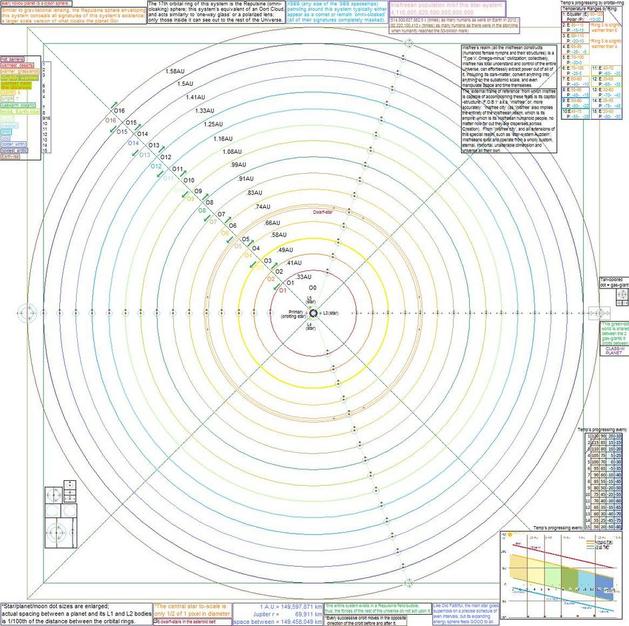
---[Population Mindset]---
Inisfreeans are as familiar with the cosmos and all its aspects as human children are with the alphabet. Because of this, Inisfreeans find it completely normal and commonplace for their star system to have dozens of planets and moons, as well as multiple stars in co-orbits. Furthermore, Inisfreeans find weird and unlikely when any world doesn't harbor intelligent and abundant forms of life.
Inisfreeans are as familiar with the cosmos and all its aspects as human children are with the alphabet. Because of this, Inisfreeans find it completely normal and commonplace for their star system to have dozens of planets and moons, as well as multiple stars in co-orbits. Furthermore, Inisfreeans find weird and unlikely when any world doesn't harbor intelligent and abundant forms of life.
---[Biology, Physiology, and Ecology]---
“Life as we know it” is a few hairs different within the Inisfreean realm of the Auzdein star-system –and that includes literally; the hairs of the Inisfreeans do not get split ends, cannot be frayed or broken, change their length, color, curliness, and volume like the tireless flexing of a muscle at will, and are, as all Inisfreean things, immortal. Beyond this, whatever enters this star system, just as whatever enters the city of Inisfree, becomes immortal to a slightly lower degree; it cannot be hurt or even grow hungry or weary, so long as that is the will of the one humanoid who governs this realm.
The flora does not require decaying matter for nourishment, and the fauna are herbivorous. Whatever plants the fauna consume, replacements quickly grow back within minutes or hours for (rather than months or years).
Also, microscopic life-forms and bugs cannot exist in the Inisfreean realm, so you won’t ever see a single ant or other ‘critter’. The same holds true for rodents and anything that would, in the realm beyond this star system and its capital city, behave in a hostile manner. While some outsiders believe such life is a mandatory part of ‘the food chain’ and ecosystems in general, this is not the case within this realm; a different balance holds true. Some outsiders claim that such life is even critical for the health of humanity, but not so within the Inisfreean borders. Even the microbes and ‘pro-biotics’ that aid in digestion fall indefinitely dormant and unneeded –a state of hibernation- when their parent organism (i.e. you, for example) explore this realm.
One of the most curious qualities of being in this realm, although no one has yet to be brave enough to notice or test it, is that the immortality effect it has on all life approved to know of and enter into this realm… works just as perfectly in the void of Outer Space; while inside this star system, anyone is instantly capable of exiting their spacecraft or spacesuit and maneuvering by pure will through the ‘black ocean’ between the worlds. If you’ve ever read a Superman comic and wondered how his humanoid species can fly around like this, an Inisfreean can both tell and show you.
In short, nothing needs to consume anything to live, as cells stop aging and being shed, and even eating plants for salads becomes entirely by habit and choice. Just like with work, Inisfreeans and those allowed inside their realm do things because they want to; not because they have to.
“Life as we know it” is a few hairs different within the Inisfreean realm of the Auzdein star-system –and that includes literally; the hairs of the Inisfreeans do not get split ends, cannot be frayed or broken, change their length, color, curliness, and volume like the tireless flexing of a muscle at will, and are, as all Inisfreean things, immortal. Beyond this, whatever enters this star system, just as whatever enters the city of Inisfree, becomes immortal to a slightly lower degree; it cannot be hurt or even grow hungry or weary, so long as that is the will of the one humanoid who governs this realm.
The flora does not require decaying matter for nourishment, and the fauna are herbivorous. Whatever plants the fauna consume, replacements quickly grow back within minutes or hours for (rather than months or years).
Also, microscopic life-forms and bugs cannot exist in the Inisfreean realm, so you won’t ever see a single ant or other ‘critter’. The same holds true for rodents and anything that would, in the realm beyond this star system and its capital city, behave in a hostile manner. While some outsiders believe such life is a mandatory part of ‘the food chain’ and ecosystems in general, this is not the case within this realm; a different balance holds true. Some outsiders claim that such life is even critical for the health of humanity, but not so within the Inisfreean borders. Even the microbes and ‘pro-biotics’ that aid in digestion fall indefinitely dormant and unneeded –a state of hibernation- when their parent organism (i.e. you, for example) explore this realm.
One of the most curious qualities of being in this realm, although no one has yet to be brave enough to notice or test it, is that the immortality effect it has on all life approved to know of and enter into this realm… works just as perfectly in the void of Outer Space; while inside this star system, anyone is instantly capable of exiting their spacecraft or spacesuit and maneuvering by pure will through the ‘black ocean’ between the worlds. If you’ve ever read a Superman comic and wondered how his humanoid species can fly around like this, an Inisfreean can both tell and show you.
In short, nothing needs to consume anything to live, as cells stop aging and being shed, and even eating plants for salads becomes entirely by habit and choice. Just like with work, Inisfreeans and those allowed inside their realm do things because they want to; not because they have to.
---[Meteorology and Climatology]---
‘O-zone holes’ cannot exist in this realm, and solar flares and winds cannot adversely affect satellites orbiting any of the Inisfreean worlds. Worlds do not have ‘ice ages’ or ‘global warming’ periods; whatever their seasonal temperature and humidity ranges are, that is what they will always be. Inclement weather also does not and cannot exist on an Inisfreean world, so tornadoes, hurricanes, whirlpools, tsunamis, monsoons, typhoons, flash floods, and even sink holes and undertows will never occur. The gustiest winds will be pleasurable and refreshing ones, and the rains will never dampen the ground to the point of any instability beyond minor puddle forming. Rapid movements through the atmosphere cannot cause damaging heat from friction, so reaching and breaking terminal velocity is not in any way dangerous, yet no foreign cosmic bodies can even reach these Inisfreean worlds’ atmospheres, let alone begin to burn up in them.
‘O-zone holes’ cannot exist in this realm, and solar flares and winds cannot adversely affect satellites orbiting any of the Inisfreean worlds. Worlds do not have ‘ice ages’ or ‘global warming’ periods; whatever their seasonal temperature and humidity ranges are, that is what they will always be. Inclement weather also does not and cannot exist on an Inisfreean world, so tornadoes, hurricanes, whirlpools, tsunamis, monsoons, typhoons, flash floods, and even sink holes and undertows will never occur. The gustiest winds will be pleasurable and refreshing ones, and the rains will never dampen the ground to the point of any instability beyond minor puddle forming. Rapid movements through the atmosphere cannot cause damaging heat from friction, so reaching and breaking terminal velocity is not in any way dangerous, yet no foreign cosmic bodies can even reach these Inisfreean worlds’ atmospheres, let alone begin to burn up in them.
---[Gas Giants]---
While radiating enough heat to keep their adjacent planets and moons pleasantly warm, gas giants in this star system do not have cores hotter than the surface of the stars. Instead, as all Inisfreean worlds and Earth-That-Was, even these giant worlds have hollow interiors complete with solid surfaces and teaming with ‘life as we know it’. Inisfreeans have not colonized the innards of these largest of their star system’s worlds, though; they are kept vacant for reasons yet unannounced.
While radiating enough heat to keep their adjacent planets and moons pleasantly warm, gas giants in this star system do not have cores hotter than the surface of the stars. Instead, as all Inisfreean worlds and Earth-That-Was, even these giant worlds have hollow interiors complete with solid surfaces and teaming with ‘life as we know it’. Inisfreeans have not colonized the innards of these largest of their star system’s worlds, though; they are kept vacant for reasons yet unannounced.
---[Sociology, the Hierarchy, and the Aristocracy]---
Inisfreean Constructs (ICs) in the Inisfreean realms (which now include this star-system along with the founding-city, Inisfree), are often flash-cloned; they blink into existence, complete with fully developed personalities and very well defined roles and senses of purpose and belonging. Because Inisfreean communication is a version of the Ansible capability and technology (from the novels saga Ender’s Game), all Inisfreeans everywhere in Creation instantly know when this occurs, who or what the newcomer is, and what she/it is all about.
The ‘chain of command’, otherwise known as the hierarchy, is surprisingly simple for a population and community of this incredible size (many billions of times larger than the human population was at any point in its own history). Each Inisfreean can perform any task, and they remain in an eternal state of mutually rotating to and through each job in their realm. This means that every Inisfreean will, at regular intervals, hold every rank and position an indefinite number of times. All Inisfreeans, however, are immediately subordinate to the Grid Mind; the sentient supercomputer being which functions as the ‘brain’ and Executive Officer (2nd in command) of the capital-city Inisfree. This Grid Mind, in turn, is immediately subordinate to the single, eternal, male humanoid founder and leader of the Inisfreean empire, Auzdein von Himmler. The one tricky part for some outsiders to initially grasp is that any Inisfreean can suddenly become the indefinite commander of the entire Inisfreean realm; this is because Lord Himmler can ‘possess’ them like the flexing of a muscle, entering their mind as the dominant consciousness to experience life from their body’s perspective. Thus, all this being said, the Inisfreean hierarchy only has and needs three tiers, even with dozens of sizes of spaceships and military units.
The entire Inisfreean population, including the Inisfreeans just this very moment flash-cloned into existence, are, by default, members of the most elite and comfortable aristocracy in Creation. There is no other class within the Inisfreean empire and realm. Even outsiders (those welcomed as guests) are treated as royalty (minus, of course, any command authority).
Inisfreean Constructs (ICs) in the Inisfreean realms (which now include this star-system along with the founding-city, Inisfree), are often flash-cloned; they blink into existence, complete with fully developed personalities and very well defined roles and senses of purpose and belonging. Because Inisfreean communication is a version of the Ansible capability and technology (from the novels saga Ender’s Game), all Inisfreeans everywhere in Creation instantly know when this occurs, who or what the newcomer is, and what she/it is all about.
The ‘chain of command’, otherwise known as the hierarchy, is surprisingly simple for a population and community of this incredible size (many billions of times larger than the human population was at any point in its own history). Each Inisfreean can perform any task, and they remain in an eternal state of mutually rotating to and through each job in their realm. This means that every Inisfreean will, at regular intervals, hold every rank and position an indefinite number of times. All Inisfreeans, however, are immediately subordinate to the Grid Mind; the sentient supercomputer being which functions as the ‘brain’ and Executive Officer (2nd in command) of the capital-city Inisfree. This Grid Mind, in turn, is immediately subordinate to the single, eternal, male humanoid founder and leader of the Inisfreean empire, Auzdein von Himmler. The one tricky part for some outsiders to initially grasp is that any Inisfreean can suddenly become the indefinite commander of the entire Inisfreean realm; this is because Lord Himmler can ‘possess’ them like the flexing of a muscle, entering their mind as the dominant consciousness to experience life from their body’s perspective. Thus, all this being said, the Inisfreean hierarchy only has and needs three tiers, even with dozens of sizes of spaceships and military units.
The entire Inisfreean population, including the Inisfreeans just this very moment flash-cloned into existence, are, by default, members of the most elite and comfortable aristocracy in Creation. There is no other class within the Inisfreean empire and realm. Even outsiders (those welcomed as guests) are treated as royalty (minus, of course, any command authority).
---[Economics]---
Technically, there is no economy within the Inisfreean realm; wealth and resources are eternally abundant, perfectly balanced, void of any costs, and available to everyone. No one is needed to distribute, inspect, or otherwise regulate any of them. Thus, there is no government or banking industry. Production is by will of the Grid Mind, which is an extension of the will of the Inisfreean dictator, Lord Himmler. Furthermore, all forms of monetary currency and bartering are banned and forbidden in this realm. You will never see a single coin, dollar, or digital credit unit, even in a museum here.
Technically, there is no economy within the Inisfreean realm; wealth and resources are eternally abundant, perfectly balanced, void of any costs, and available to everyone. No one is needed to distribute, inspect, or otherwise regulate any of them. Thus, there is no government or banking industry. Production is by will of the Grid Mind, which is an extension of the will of the Inisfreean dictator, Lord Himmler. Furthermore, all forms of monetary currency and bartering are banned and forbidden in this realm. You will never see a single coin, dollar, or digital credit unit, even in a museum here.
---[Immortality and Recall Beyond the Inisfreean Realm]---
Inisfreeans remain immortal no matter where they go in Creation, but outsiders must learn how to achieve this for themselves. Inisfreeans are happy to offer suggestions, training, and so on, but, ultimately, it is always up to the being(s) in question to figure it out and stabilize it for themselves.
Inisfreeans can effortlessly ‘port’ (the Inisfreean version of teleporting, which is smooth, silent, and leaves no energy signature or shockwave behind) back to wherever they want in the Inisfreean realm. Just like the changing of their iris, hair, and skin color, this is like easy muscle-flexing for them. And, because Inisfreeans cannot grow hungry or weary, this action consumes no energy. The only time an Inisfreean may appear ‘worn out’ is if they become emotionally stressed, such as by being apart from other Inisfreeans for longer than a few years. Although this couldn’t be accurately called their ‘kryptonite’ (because it does not, in any way, diminish their incredible abilities in terms of strength, speed, cognitive acuity, or longevity), this does still result in noticeable changes (of outward mood, at least) under various circumstances. However, it is important to note that even in the lowest of moods, when their ‘life force’ (sometimes called an ‘aura’, although that is, more accurately, just the portion of the life-force radiated out around the body like a semi-visible/feelable aurora) seems all but completely diminished due to clear, emotional depression, Inisfreeans can instantly be recalled (or recall themselves) via this innate ‘porting’ ability.
Inisfreeans remain immortal no matter where they go in Creation, but outsiders must learn how to achieve this for themselves. Inisfreeans are happy to offer suggestions, training, and so on, but, ultimately, it is always up to the being(s) in question to figure it out and stabilize it for themselves.
Inisfreeans can effortlessly ‘port’ (the Inisfreean version of teleporting, which is smooth, silent, and leaves no energy signature or shockwave behind) back to wherever they want in the Inisfreean realm. Just like the changing of their iris, hair, and skin color, this is like easy muscle-flexing for them. And, because Inisfreeans cannot grow hungry or weary, this action consumes no energy. The only time an Inisfreean may appear ‘worn out’ is if they become emotionally stressed, such as by being apart from other Inisfreeans for longer than a few years. Although this couldn’t be accurately called their ‘kryptonite’ (because it does not, in any way, diminish their incredible abilities in terms of strength, speed, cognitive acuity, or longevity), this does still result in noticeable changes (of outward mood, at least) under various circumstances. However, it is important to note that even in the lowest of moods, when their ‘life force’ (sometimes called an ‘aura’, although that is, more accurately, just the portion of the life-force radiated out around the body like a semi-visible/feelable aurora) seems all but completely diminished due to clear, emotional depression, Inisfreeans can instantly be recalled (or recall themselves) via this innate ‘porting’ ability.
---[Romance and Sex]---
Inisfreeans are innately polyamorous and will have carefree sex and orgies with anyone they find beautiful and otherwise attractive. Social problems are not possible between Inisfreeans, and it is the straying from this lifestyle, rather than the indulging in it, which Inisfreeans know results in said types of problems. No matter what the occasion or relationship is, every Inisfreean will be just as romantic, and give just as much meaningful love and attention, to everyone they feel called and aroused to share such things with.
It is important to keep in mind that diseases, STD or otherwise, are impossible for anyone within the realm of the Inisfreeans, as well as for Inisfreeans within any realm. When an Inisfreean wills (chooses) it, even the most confused and poisoned outsider, even in the most remote and negative of outside realms, can be instantly and permanently cured of their STD(s) (and any other diseases and ailments) just by being in the general proximity (or even vicinity) of the newest and youngest of the Inisfreeans. This was, after all, prophesied by humans such as Jesus; that those who believe would become able to do even greater works than his; even greater works than god’s.
Inisfreeans are innately polyamorous and will have carefree sex and orgies with anyone they find beautiful and otherwise attractive. Social problems are not possible between Inisfreeans, and it is the straying from this lifestyle, rather than the indulging in it, which Inisfreeans know results in said types of problems. No matter what the occasion or relationship is, every Inisfreean will be just as romantic, and give just as much meaningful love and attention, to everyone they feel called and aroused to share such things with.
It is important to keep in mind that diseases, STD or otherwise, are impossible for anyone within the realm of the Inisfreeans, as well as for Inisfreeans within any realm. When an Inisfreean wills (chooses) it, even the most confused and poisoned outsider, even in the most remote and negative of outside realms, can be instantly and permanently cured of their STD(s) (and any other diseases and ailments) just by being in the general proximity (or even vicinity) of the newest and youngest of the Inisfreeans. This was, after all, prophesied by humans such as Jesus; that those who believe would become able to do even greater works than his; even greater works than god’s.
---[Linguistics]---
Due to the Inisfreean Neural Network (I.N.N.), the Grid Mind, how Inisfreean brains and thoughts work (they are capable of telepathy and mind-probing if given permission), and the nature of languages in general, each Inisfreean can, within a matter of hours (and sometimes much less), gain a fluency in any language, spoken, written, hand-signed, or otherwise. Thus, all Inisfreeans can speak all languages –and not just from Earth-That-Was (which had more than 6,900 distinct languages before the terraforming event and military Rapture campaign of 2013 AD). C3PO, eat your heart out.
Due to the Inisfreean Neural Network (I.N.N.), the Grid Mind, how Inisfreean brains and thoughts work (they are capable of telepathy and mind-probing if given permission), and the nature of languages in general, each Inisfreean can, within a matter of hours (and sometimes much less), gain a fluency in any language, spoken, written, hand-signed, or otherwise. Thus, all Inisfreeans can speak all languages –and not just from Earth-That-Was (which had more than 6,900 distinct languages before the terraforming event and military Rapture campaign of 2013 AD). C3PO, eat your heart out.
---[Reproduction and Essence]---
For Inisfreeans, reproduction is not a result of exchanging sexual fluids, nor do Inisfreeans even have reproductive sex organs from which genetic material could be extracted for artificial reproduction processes. Inisfreeans are reproduced only by will of Lord Auzdein, via the direction of Inisfree city’s Grid Mind, which engineers the genetic sequence of each Inisfreean based on Lord Auzdein’s envisioned end result, and grows them in Inisfree’s cloning facilities by singing the air above their pedestals into new subatomic states and arrangements.
An Inisfreean is basically this: if a nymph, a supercomputer, an elf, a xenomorph, a fairy, a Kryptonian (such as Supergirl or Superman), and an interstellar, biomechanical starship were combined into one humanoid being. Inisfreeans are the quintessence of humanity –even though they are decidedly not human.
For Inisfreeans, reproduction is not a result of exchanging sexual fluids, nor do Inisfreeans even have reproductive sex organs from which genetic material could be extracted for artificial reproduction processes. Inisfreeans are reproduced only by will of Lord Auzdein, via the direction of Inisfree city’s Grid Mind, which engineers the genetic sequence of each Inisfreean based on Lord Auzdein’s envisioned end result, and grows them in Inisfree’s cloning facilities by singing the air above their pedestals into new subatomic states and arrangements.
An Inisfreean is basically this: if a nymph, a supercomputer, an elf, a xenomorph, a fairy, a Kryptonian (such as Supergirl or Superman), and an interstellar, biomechanical starship were combined into one humanoid being. Inisfreeans are the quintessence of humanity –even though they are decidedly not human.
---[Sentient Conscious Biomechanics]---
All ICs (be they Inisfreean girls, Inisfreean buildings, Inisfreean vehicles, Inisfreean weapons, or even Inisfreean plants and landscaping) are part of the I.N.N., and effortlessly, rapidly re-grow themselves to ‘heal’. Although nothing can take damage or otherwise be wounded or unattractively altered in the Inisfreean realm, sometimes an imminent, high speed impact will be mitigated by changing the structural integrity of the relatively ‘inanimate’ objects in the Inisfreean realm; a boulder or building façade might temporarily soften or move out of the way to avoid unintended collisions, while the wind and atmospheric density increase just enough to compensate in another way. This is extremely rare, as Repulsine engines constantly regulate motion and traction, as well, but it will be experienced from time to time –and almost always by choice, as all Inisfreean things are.
Because everything in the Inisfreean realm is conscious, no one needs to monitor or override anything, yet simultaneously, everything technically is able to monitor everything else, because, again, everything there is conscious, and because of the instantaneous, collective-consciousness though process that pass around in the I.N.N. –between the humanoid Inisfreeans (the girls) and all other Inisfreean constructs; the buildings, plants, and even the worlds and stars themselves.
All ICs (be they Inisfreean girls, Inisfreean buildings, Inisfreean vehicles, Inisfreean weapons, or even Inisfreean plants and landscaping) are part of the I.N.N., and effortlessly, rapidly re-grow themselves to ‘heal’. Although nothing can take damage or otherwise be wounded or unattractively altered in the Inisfreean realm, sometimes an imminent, high speed impact will be mitigated by changing the structural integrity of the relatively ‘inanimate’ objects in the Inisfreean realm; a boulder or building façade might temporarily soften or move out of the way to avoid unintended collisions, while the wind and atmospheric density increase just enough to compensate in another way. This is extremely rare, as Repulsine engines constantly regulate motion and traction, as well, but it will be experienced from time to time –and almost always by choice, as all Inisfreean things are.
Because everything in the Inisfreean realm is conscious, no one needs to monitor or override anything, yet simultaneously, everything technically is able to monitor everything else, because, again, everything there is conscious, and because of the instantaneous, collective-consciousness though process that pass around in the I.N.N. –between the humanoid Inisfreeans (the girls) and all other Inisfreean constructs; the buildings, plants, and even the worlds and stars themselves.
---[Transportation]---
While any Inisfreean can will you to ‘port’ (teleport; either by yourself, or with them) anywhere you or they desire, Inisfreeans typically choose to drive or fly around their communities and realm via Inisfreean vehicles and aerospacecraft, such as luxury cars, luxury mobile homes, luxury jets, luxury dropships, and luxury warships (yes, just about everything the Inisfreeans make is extremely luxurious –because why not??). Taking the slower, ‘scenic’ route is often more rewarding, and Inisfreeans are extensions of the mentality and memes of their leader, Lord Auzdein; thus, all of them firmly believe in the proverb that ‘the journey is the destination’.
When ‘porting’ (teleporting), speed is not changed (one simply remains where they are, and a portal opens and moves around them, closing back up behind them, and is so finely tuned and seamless that it might as well be a single layer of atoms of the wind passing snugly over the surface of their skin like a gentle caress). Also, when ‘porting’, collisions are impossible; ‘no two things can exist in the same place at the same time’, and since everything in the Inisfreean realm, including the realm and its void (Outer Space) itself are conscious and a part of the Inisfreean collective (the I.N.N., et cetera), if a collision seemed possible, the realm would adjust the potentially affected components accordingly and in perfect time.
While any Inisfreean can will you to ‘port’ (teleport; either by yourself, or with them) anywhere you or they desire, Inisfreeans typically choose to drive or fly around their communities and realm via Inisfreean vehicles and aerospacecraft, such as luxury cars, luxury mobile homes, luxury jets, luxury dropships, and luxury warships (yes, just about everything the Inisfreeans make is extremely luxurious –because why not??). Taking the slower, ‘scenic’ route is often more rewarding, and Inisfreeans are extensions of the mentality and memes of their leader, Lord Auzdein; thus, all of them firmly believe in the proverb that ‘the journey is the destination’.
When ‘porting’ (teleporting), speed is not changed (one simply remains where they are, and a portal opens and moves around them, closing back up behind them, and is so finely tuned and seamless that it might as well be a single layer of atoms of the wind passing snugly over the surface of their skin like a gentle caress). Also, when ‘porting’, collisions are impossible; ‘no two things can exist in the same place at the same time’, and since everything in the Inisfreean realm, including the realm and its void (Outer Space) itself are conscious and a part of the Inisfreean collective (the I.N.N., et cetera), if a collision seemed possible, the realm would adjust the potentially affected components accordingly and in perfect time.
---[Lord Auzdein von Himmler]---
Once called ‘The Governor’ (during Inisfree city’s first few centuries of operational status), Auzdein of Antarktis (that’s German for ‘Antarctica’, where the fully-mobile starship-city Inisfree remains anchored) has enjoyed a growing list of official and formal titles much like the other royals who grew kingdoms and empires of their own. Some of his current titles include:
And while he enjoys god-like status on Illium (and all asari worlds), he is a god (the god) on all worlds in star-system Auzdein; his will instantly adjusts and constantly controls every particle within this realm, just as it does within its capital city, Inisfree.
Once called ‘The Governor’ (during Inisfree city’s first few centuries of operational status), Auzdein of Antarktis (that’s German for ‘Antarctica’, where the fully-mobile starship-city Inisfree remains anchored) has enjoyed a growing list of official and formal titles much like the other royals who grew kingdoms and empires of their own. Some of his current titles include:
- Sir Auzdein von Himmler, First Knight of the Human Empire
- Lord Auzdein of Inisfree
- Commander of the Inisfreean Holy Military
- Overseer of Humanity
- Founding Father of Inisfree, the Inisfreeans, and Auzdeinianity
- Prime Protector of Gaia and the Realm
- Dictator and God-king of Inisfree and star-system Auzdein
And while he enjoys god-like status on Illium (and all asari worlds), he is a god (the god) on all worlds in star-system Auzdein; his will instantly adjusts and constantly controls every particle within this realm, just as it does within its capital city, Inisfree.
---[Planet Data]---
Stellar ID:
Class:
Radius:
Mass:
Keplerian Ratio:
Stellar ID:
Class:
Radius:
Mass:
Keplerian Ratio:
Luminosity:
Surface Temperature:
Day Length:Surface Temperature:
Surface Gravity:
Atmospheric Pressure:
Atmospheric Pressure:
Orbital Distance:
Orbital Period:
Orbital Period:
---[Status]---
Colonized:
Terraformed:
---[Moons]---
0
---[Rings]---
0
---[Artificial Satellites]---
0
---[Indigenous]---
Inisfreeans
Colonized:
Terraformed:
---[Moons]---
0
---[Rings]---
0
---[Artificial Satellites]---
0
---[Indigenous]---
Inisfreeans
---[Planet Data]---
Stellar ID:
Class:
Radius:
Mass:
Keplerian Ratio:
Stellar ID:
Class:
Radius:
Mass:
Keplerian Ratio:
Luminosity:
Surface Temperature:
Day Length:Surface Temperature:
Surface Gravity:
Atmospheric Pressure:
Atmospheric Pressure:
Orbital Distance:
Orbital Period:
Orbital Period:
---[Status]---
Colonized:
Terraformed:
---[Moons]---
0
---[Rings]---
0
---[Artificial Satellites]---
0
---[Indigenous]---
Inisfreeans
Colonized:
Terraformed:
---[Moons]---
0
---[Rings]---
0
---[Artificial Satellites]---
0
---[Indigenous]---
Inisfreeans
---[Planet Data]---
Stellar ID:
Class:
Radius:
Mass:
Keplerian Ratio:
Stellar ID:
Class:
Radius:
Mass:
Keplerian Ratio:
Luminosity:
Surface Temperature:
Day Length:Surface Temperature:
Surface Gravity:
Atmospheric Pressure:
Atmospheric Pressure:
Orbital Distance:
Orbital Period:
Orbital Period:
---[Status]---
Colonized:
Terraformed:
---[Moons]---
0
---[Rings]---
0
---[Artificial Satellites]---
0
---[Indigenous]---
Inisfreeans
Colonized:
Terraformed:
---[Moons]---
0
---[Rings]---
0
---[Artificial Satellites]---
0
---[Indigenous]---
Inisfreeans
---[Planet Data]---
Stellar ID:
Class:
Radius:
Mass:
Keplerian Ratio:
Stellar ID:
Class:
Radius:
Mass:
Keplerian Ratio:
Luminosity:
Surface Temperature:
Day Length:Surface Temperature:
Surface Gravity:
Atmospheric Pressure:
Atmospheric Pressure:
Orbital Distance:
Orbital Period:
Orbital Period:
---[Status]---
Colonized:
Terraformed:
---[Moons]---
0
---[Rings]---
0
---[Artificial Satellites]---
0
---[Indigenous]---
Inisfreeans
Colonized:
Terraformed:
---[Moons]---
0
---[Rings]---
0
---[Artificial Satellites]---
0
---[Indigenous]---
Inisfreeans
---[Planet Data]---
Stellar ID:
Class:
Radius:
Mass:
Keplerian Ratio:
Stellar ID:
Class:
Radius:
Mass:
Keplerian Ratio:
Luminosity:
Surface Temperature:
Day Length:Surface Temperature:
Surface Gravity:
Atmospheric Pressure:
Atmospheric Pressure:
Orbital Distance:
Orbital Period:
Orbital Period:
---[Status]---
Colonized:
Terraformed:
---[Moons]---
0
---[Rings]---
0
---[Artificial Satellites]---
0
---[Indigenous]---
Inisfreeans
Colonized:
Terraformed:
---[Moons]---
0
---[Rings]---
0
---[Artificial Satellites]---
0
---[Indigenous]---
Inisfreeans
---[Planet Data]---
Stellar ID:
Class:
Radius:
Mass:
Keplerian Ratio:
Stellar ID:
Class:
Radius:
Mass:
Keplerian Ratio:
Luminosity:
Surface Temperature:
Day Length:Surface Temperature:
Surface Gravity:
Atmospheric Pressure:
Atmospheric Pressure:
Orbital Distance:
Orbital Period:
Orbital Period:
---[Status]---
Colonized:
Terraformed:
---[Moons]---
1: Seh
---[Rings]---
0
---[Artificial Satellites]---
0
---[Indigenous]---
Inisfreeans
Colonized:
Terraformed:
---[Moons]---
1: Seh
---[Rings]---
0
---[Artificial Satellites]---
0
---[Indigenous]---
Inisfreeans
---[Moon Data]---
Stellar ID:
Class:
Radius:
Mass:
Keplerian Ratio:
Stellar ID:
Class:
Radius:
Mass:
Keplerian Ratio:
Luminosity:
Surface Temperature:
Day Length:Surface Temperature:
Surface Gravity:
Atmospheric Pressure:
Atmospheric Pressure:
Orbital Distance:
Orbital Period:
Orbital Period:
---[Status]---
Colonized:
Terraformed:
---[Moons]---
0
---[Rings]---
0
---[Artificial Satellites]---
0
---[Indigenous]---
Inisfreeans
Colonized:
Terraformed:
---[Moons]---
0
---[Rings]---
0
---[Artificial Satellites]---
0
---[Indigenous]---
Inisfreeans
---[Planet Data]---
Stellar ID:
Class:
Radius:
Mass:
Keplerian Ratio:
Stellar ID:
Class:
Radius:
Mass:
Keplerian Ratio:
Luminosity:
Surface Temperature:
Day Length:Surface Temperature:
Surface Gravity:
Atmospheric Pressure:
Atmospheric Pressure:
Orbital Distance:
Orbital Period:
Orbital Period:
---[Status]---
Colonized:
Terraformed:
---[Moons]---
1: Sth
---[Rings]---
0
---[Artificial Satellites]---
0
---[Indigenous]---
Inisfreeans
Colonized:
Terraformed:
---[Moons]---
1: Sth
---[Rings]---
0
---[Artificial Satellites]---
0
---[Indigenous]---
Inisfreeans
---[Moon Data]---
Stellar ID:
Class:
Radius:
Mass:
Keplerian Ratio:
Stellar ID:
Class:
Radius:
Mass:
Keplerian Ratio:
Luminosity:
Surface Temperature:
Day Length:Surface Temperature:
Surface Gravity:
Atmospheric Pressure:
Atmospheric Pressure:
Orbital Distance:
Orbital Period:
Orbital Period:
---[Status]---
Colonized:
Terraformed:
---[Moons]---
0
---[Rings]---
0
---[Artificial Satellites]---
0
---[Indigenous]---
Inisfreeans
Colonized:
Terraformed:
---[Moons]---
0
---[Rings]---
0
---[Artificial Satellites]---
0
---[Indigenous]---
Inisfreeans
---[Planet Data]---
Stellar ID:
Class:
Radius:
Mass:
Keplerian Ratio:
Stellar ID:
Class:
Radius:
Mass:
Keplerian Ratio:
Luminosity:
Surface Temperature:
Day Length:Surface Temperature:
Surface Gravity:
Atmospheric Pressure:
Atmospheric Pressure:
Orbital Distance:
Orbital Period:
Orbital Period:
---[Status]---
Colonized:
Terraformed:
---[Moons]---
1: Lah
---[Rings]---
0
---[Artificial Satellites]---
0
---[Indigenous]---
Inisfreeans
Colonized:
Terraformed:
---[Moons]---
1: Lah
---[Rings]---
0
---[Artificial Satellites]---
0
---[Indigenous]---
Inisfreeans
---[Moon Data]---
Stellar ID:
Class:
Radius:
Mass:
Keplerian Ratio:
Stellar ID:
Class:
Radius:
Mass:
Keplerian Ratio:
Luminosity:
Surface Temperature:
Day Length:Surface Temperature:
Surface Gravity:
Atmospheric Pressure:
Atmospheric Pressure:
Orbital Distance:
Orbital Period:
Orbital Period:
---[Status]---
Colonized:
Terraformed:
---[Moons]---
0
---[Rings]---
0
---[Artificial Satellites]---
0
---[Indigenous]---
Inisfreeans
Colonized:
Terraformed:
---[Moons]---
0
---[Rings]---
0
---[Artificial Satellites]---
0
---[Indigenous]---
Inisfreeans
---[Planet Data]---
Stellar ID:
Class:
Radius:
Mass:
Keplerian Ratio:
Stellar ID:
Class:
Radius:
Mass:
Keplerian Ratio:
Luminosity:
Surface Temperature:
Day Length:Surface Temperature:
Surface Gravity:
Atmospheric Pressure:
Atmospheric Pressure:
Orbital Distance:
Orbital Period:
Orbital Period:
---[Status]---
Colonized:
Terraformed:
---[Moons]---
1: Lis
---[Rings]---
0
---[Artificial Satellites]---
0
---[Indigenous]---
Inisfreeans
Colonized:
Terraformed:
---[Moons]---
1: Lis
---[Rings]---
0
---[Artificial Satellites]---
0
---[Indigenous]---
Inisfreeans
---[Moon Data]---
Stellar ID:
Class:
Radius:
Mass:
Keplerian Ratio:
Stellar ID:
Class:
Radius:
Mass:
Keplerian Ratio:
Luminosity:
Surface Temperature:
Day Length:Surface Temperature:
Surface Gravity:
Atmospheric Pressure:
Atmospheric Pressure:
Orbital Distance:
Orbital Period:
Orbital Period:
---[Status]---
Colonized:
Terraformed:
---[Moons]---
0
---[Rings]---
0
---[Artificial Satellites]---
0
---[Indigenous]---
Inisfreeans
Colonized:
Terraformed:
---[Moons]---
0
---[Rings]---
0
---[Artificial Satellites]---
0
---[Indigenous]---
Inisfreeans
---[Planet Data]---
Stellar ID:
Class:
Radius:
Mass:
Keplerian Ratio:
Stellar ID:
Class:
Radius:
Mass:
Keplerian Ratio:
Luminosity:
Surface Temperature:
Day Length:Surface Temperature:
Surface Gravity:
Atmospheric Pressure:
Atmospheric Pressure:
Orbital Distance:
Orbital Period:
Orbital Period:
---[Status]---
Colonized:
Terraformed:
---[Moons]---
0
---[Rings]---
0
---[Artificial Satellites]---
0
---[Indigenous]---
Inisfreeans
Colonized:
Terraformed:
---[Moons]---
0
---[Rings]---
0
---[Artificial Satellites]---
0
---[Indigenous]---
Inisfreeans
---[Planet Data]---
Stellar ID:
Class:
Radius:
Mass:
Keplerian Ratio:
Stellar ID:
Class:
Radius:
Mass:
Keplerian Ratio:
Luminosity:
Surface Temperature:
Day Length:Surface Temperature:
Surface Gravity:
Atmospheric Pressure:
Atmospheric Pressure:
Orbital Distance:
Orbital Period:
Orbital Period:
---[Status]---
Colonized:
Terraformed:
---[Moons]---
0
---[Rings]---
0
---[Artificial Satellites]---
0
---[Indigenous]---
Inisfreeans
Colonized:
Terraformed:
---[Moons]---
0
---[Rings]---
0
---[Artificial Satellites]---
0
---[Indigenous]---
Inisfreeans
---[Planet Data]---
Stellar ID:
Class:
Radius:
Mass:
Keplerian Ratio:
Stellar ID:
Class:
Radius:
Mass:
Keplerian Ratio:
Luminosity:
Surface Temperature:
Day Length:Surface Temperature:
Surface Gravity:
Atmospheric Pressure:
Atmospheric Pressure:
Orbital Distance:
Orbital Period:
Orbital Period:
---[Status]---
Colonized:
Terraformed:
---[Moons]---
1: Cam
---[Rings]---
0
---[Artificial Satellites]---
0
---[Indigenous]---
Inisfreeans
Colonized:
Terraformed:
---[Moons]---
1: Cam
---[Rings]---
0
---[Artificial Satellites]---
0
---[Indigenous]---
Inisfreeans
---[Moon Data]---
Stellar ID:
Class:
Radius:
Mass:
Keplerian Ratio:
Stellar ID:
Class:
Radius:
Mass:
Keplerian Ratio:
Luminosity:
Surface Temperature:
Day Length:Surface Temperature:
Surface Gravity:
Atmospheric Pressure:
Atmospheric Pressure:
Orbital Distance:
Orbital Period:
Orbital Period:
---[Status]---
Colonized:
Terraformed:
---[Moons]---
0
---[Rings]---
0
---[Artificial Satellites]---
0
---[Indigenous]---
Inisfreeans
Colonized:
Terraformed:
---[Moons]---
0
---[Rings]---
0
---[Artificial Satellites]---
0
---[Indigenous]---
Inisfreeans
---[Planet Data]---
Stellar ID:
Class:
Radius:
Mass:
Keplerian Ratio:
Stellar ID:
Class:
Radius:
Mass:
Keplerian Ratio:
Luminosity:
Surface Temperature:
Day Length:Surface Temperature:
Surface Gravity:
Atmospheric Pressure:
Atmospheric Pressure:
Orbital Distance:
Orbital Period:
Orbital Period:
---[Status]---
Colonized:
Terraformed:
---[Moons]---
1: Var
---[Rings]---
0
---[Artificial Satellites]---
0
---[Indigenous]---
Inisfreeans
Colonized:
Terraformed:
---[Moons]---
1: Var
---[Rings]---
0
---[Artificial Satellites]---
0
---[Indigenous]---
Inisfreeans
---[Moon Data]---
Stellar ID:
Class:
Radius:
Mass:
Keplerian Ratio:
Stellar ID:
Class:
Radius:
Mass:
Keplerian Ratio:
Luminosity:
Surface Temperature:
Day Length:Surface Temperature:
Surface Gravity:
Atmospheric Pressure:
Atmospheric Pressure:
Orbital Distance:
Orbital Period:
Orbital Period:
---[Status]---
Colonized:
Terraformed:
---[Moons]---
0
---[Rings]---
0
---[Artificial Satellites]---
0
---[Indigenous]---
Inisfreeans
Colonized:
Terraformed:
---[Moons]---
0
---[Rings]---
0
---[Artificial Satellites]---
0
---[Indigenous]---
Inisfreeans
---[Planet Data]---
Stellar ID:
Class:
Radius:
Mass:
Keplerian Ratio:
Stellar ID:
Class:
Radius:
Mass:
Keplerian Ratio:
Luminosity:
Surface Temperature:
Day Length:Surface Temperature:
Surface Gravity:
Atmospheric Pressure:
Atmospheric Pressure:
Orbital Distance:
Orbital Period:
Orbital Period:
---[Status]---
Colonized:
Terraformed:
---[Moons]---
1: Bin
---[Rings]---
0
---[Artificial Satellites]---
0
---[Indigenous]---
Inisfreeans
Colonized:
Terraformed:
---[Moons]---
1: Bin
---[Rings]---
0
---[Artificial Satellites]---
0
---[Indigenous]---
Inisfreeans
---[Moon Data]---
Stellar ID:
Class:
Radius:
Mass:
Keplerian Ratio:
Stellar ID:
Class:
Radius:
Mass:
Keplerian Ratio:
Luminosity:
Surface Temperature:
Day Length:Surface Temperature:
Surface Gravity:
Atmospheric Pressure:
Atmospheric Pressure:
Orbital Distance:
Orbital Period:
Orbital Period:
---[Status]---
Colonized:
Terraformed:
---[Moons]---
0
---[Rings]---
0
---[Artificial Satellites]---
0
---[Indigenous]---
Inisfreeans
Colonized:
Terraformed:
---[Moons]---
0
---[Rings]---
0
---[Artificial Satellites]---
0
---[Indigenous]---
Inisfreeans
---[Planet Data]---
Stellar ID:
Class:
Radius:
Mass:
Keplerian Ratio:
Stellar ID:
Class:
Radius:
Mass:
Keplerian Ratio:
Luminosity:
Surface Temperature:
Day Length:Surface Temperature:
Surface Gravity:
Atmospheric Pressure:
Atmospheric Pressure:
Orbital Distance:
Orbital Period:
Orbital Period:
---[Status]---
Colonized:
Terraformed:
---[Moons]---
1: Age ("Ae-geh")
---[Rings]---
0
---[Artificial Satellites]---
0
---[Indigenous]---
Inisfreeans
Colonized:
Terraformed:
---[Moons]---
1: Age ("Ae-geh")
---[Rings]---
0
---[Artificial Satellites]---
0
---[Indigenous]---
Inisfreeans
Auzdein (2517) 0P
M
6,500 km
1.0 Earth Masses
(N/A) #.##
N/A
80 - -5 °F
1.0 g
1.00 atm
0.00 AU
.08 Earth Years (EY); 30 days
24.0 Earth Hours
Auzdein (2517) 0L3
M
6,500 km
1.0 Earth Masses
(N/A) #.##
N/A
80 - -5 °F
1.0 g
1.00 atm
0.00 AU
.08 EY; 30 days
24.0 Earth Hours
Auzdein (2517) 0L4
M
6,500 km
1.0 Earth Masses
(N/A) #.##
N/A
80 - -5 °F
1.0 g
1.00 atm
0.00 AU
.08 EY; 30 days
24.0 Earth Hours
Auzdein (2517) 0L5
M
6,500 km
1.0 Earth Masses
(N/A) #.##
N/A
80 - -5 °F
1.0 g
1.00 atm
0.00 AU
.08 EY; 30 days
24.0 Earth Hours
Auzdein (2517) 1P
M
6,500 km
1.0 Earth Masses
(N/A) #.##
N/A
120 - -10 °F
1.0 g
1.00 atm
.33 AU
.33 EY; 120 days
24.0 Earth Hours
Auzdein (2517) 1PM
M
6,500 km
1.0 Earth Masses
(N/A) #.##
N/A
120 - -10 °F
1.0 g
1.00 atm
.33 AU
30 Earth Days
24.0 Earth Hours
Auzdein (2517) 1L3
M
6,500 km
1.0 Earth Masses
(N/A) #.##
N/A
120 - -10 °F
1.0 g
1.00 atm
.33 AU
.33 EY; 120 days
24.0 Earth Hours
Auzdein (2517) 1L3M
M
6,500 km
1.0 Earth Masses
(N/A) #.##
N/A
120 - -10 °F
1.0 g
1.00 atm
.33 AU
30 Earth Days
24.0 Earth Hours
Auzdein (2517) 1L4
M
6,500 km
1.0 Earth Masses
(N/A) #.##
N/A
120 - -10 °F
1.0 g
1.00 atm
.33 AU
.33 EY; 120 days
24.0 Earth Hours
Auzdein (2517) 1L4M
M
6,500 km
1.0 Earth Masses
(N/A) #.##
N/A
120 - -10 °F
1.0 g
1.00 atm
.33 AU
30 Earth Days
24.0 Earth Hours
Auzdein (2517) 1L5
M
6,500 km
1.0 Earth Masses
(N/A) #.##
N/A
120 - -10 °F
1.0 g
1.00 atm
.33 AU
.33 EY; 120 days
24.0 Earth Hours
Auzdein (2517) 1L5M
M
6,500 km
1.0 Earth Masses
(N/A) #.##
N/A
120 - -10 °F
1.0 g
1.00 atm
.33 AU
30 Earth Days
24.0 Earth Hours
Auzdein (2517) 1L1
M
6,500 km
1.0 Earth Masses
(N/A) #.##
N/A
120 - -10 °F
1.0 g
1.00 atm
.33 AU
.33 EY; 120 days
24.0 Earth Hours
Auzdein (2517) 1L2
M
6,500 km
1.0 Earth Masses
(N/A) #.##
N/A
120 - -10 °F
1.0 g
1.00 atm
.33 AU
.33 EY; 120 days
24.0 Earth Hours
Auzdein (2517) 2P
M
6,500 km
1.0 Earth Masses
(N/A) #.##
N/A
115 - -15 °F
1.0 g
1.00 atm
.41 AU
.41 EY; 150 days
24.0 Earth Hours
Auzdein (2517) 2PM
M
6,500 km
1.0 Earth Masses
(N/A) #.##
N/A
115 - -15 °F
1.0 g
1.00 atm
.41 AU
30 Earth Days
24.0 Earth Hours
---[Moon Data]---
Stellar ID:
Class:
Radius:
Mass:
Keplerian Ratio:
Stellar ID:
Class:
Radius:
Mass:
Keplerian Ratio:
Luminosity:
Surface Temperature:
Day Length:Surface Temperature:
Surface Gravity:
Atmospheric Pressure:
Atmospheric Pressure:
Orbital Distance:
Orbital Period:
Orbital Period:
---[Status]---
Colonized:
Terraformed:
---[Moons]---
0
---[Rings]---
0
---[Artificial Satellites]---
0
---[Indigenous]---
Inisfreeans
Colonized:
Terraformed:
---[Moons]---
0
---[Rings]---
0
---[Artificial Satellites]---
0
---[Indigenous]---
Inisfreeans
---[Planet Data]---
Stellar ID:
Class:
Radius:
Mass:
Keplerian Ratio:
Stellar ID:
Class:
Radius:
Mass:
Keplerian Ratio:
Luminosity:
Surface Temperature:
Day Length:Surface Temperature:
Surface Gravity:
Atmospheric Pressure:
Atmospheric Pressure:
Orbital Distance:
Orbital Period:
Orbital Period:
---[Status]---
Colonized:
Terraformed:
---[Moons]---
0
---[Rings]---
0
---[Artificial Satellites]---
0
---[Indigenous]---
Inisfreeans
Colonized:
Terraformed:
---[Moons]---
0
---[Rings]---
0
---[Artificial Satellites]---
0
---[Indigenous]---
Inisfreeans
---[Planet Data]---
Stellar ID:
Class:
Radius:
Mass:
Keplerian Ratio:
Stellar ID:
Class:
Radius:
Mass:
Keplerian Ratio:
Luminosity:
Surface Temperature:
Day Length:Surface Temperature:
Surface Gravity:
Atmospheric Pressure:
Atmospheric Pressure:
Orbital Distance:
Orbital Period:
Orbital Period:
---[Status]---
Colonized:
Terraformed:
---[Moons]---
0
---[Rings]---
0
---[Artificial Satellites]---
0
---[Indigenous]---
Inisfreeans
Colonized:
Terraformed:
---[Moons]---
0
---[Rings]---
0
---[Artificial Satellites]---
0
---[Indigenous]---
Inisfreeans
Note:
Tanj, the primary world of this stellar-interior orbit, has a ring system which quintuples its occupied Space. An O-class world, its surface is underwater, both polar regions being frozen beneath ice and snow caps, and its few large islands being rainforest tropical paradises.
Tanj, the primary world of this stellar-interior orbit, has a ring system which quintuples its occupied Space. An O-class world, its surface is underwater, both polar regions being frozen beneath ice and snow caps, and its few large islands being rainforest tropical paradises.
---[Vantages and Appearances]---
All planets and moons in this star system are set at respective distances from one another such that from the parent body, the moons will always be the same size in the sky as the Moon is from Earth.
Worlds at the Lagrangian points will appear as colored pinpoints.
All planets and moons in this star system are set at respective distances from one another such that from the parent body, the moons will always be the same size in the sky as the Moon is from Earth.
Worlds at the Lagrangian points will appear as colored pinpoints.
Note
The only Inisfreean world to be tidally locked, Tsuwa is half frozen; its inward-facing hemisphere pointing toward the hollow core’s central point where no light is generated at all, resulting in this side of it remaining frozen under an ice and snow cap even deeper than that of Antarctica’s, while its hemisphere facing out toward the two solar polar holes it orbits between… has a permanent ‘Great Eye’ storm; a hurricane fixated about the center of this warm hemisphere.
The only Inisfreean world to be tidally locked, Tsuwa is half frozen; its inward-facing hemisphere pointing toward the hollow core’s central point where no light is generated at all, resulting in this side of it remaining frozen under an ice and snow cap even deeper than that of Antarctica’s, while its hemisphere facing out toward the two solar polar holes it orbits between… has a permanent ‘Great Eye’ storm; a hurricane fixated about the center of this warm hemisphere.
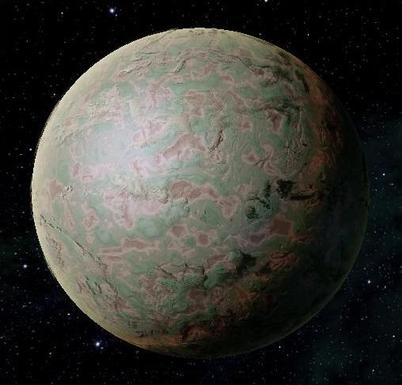
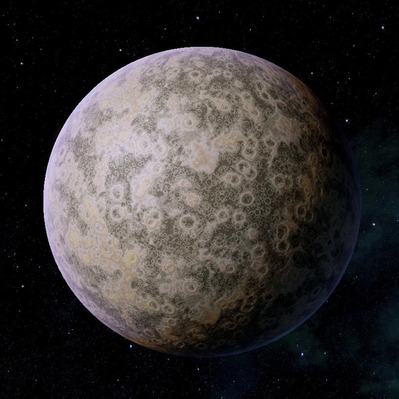
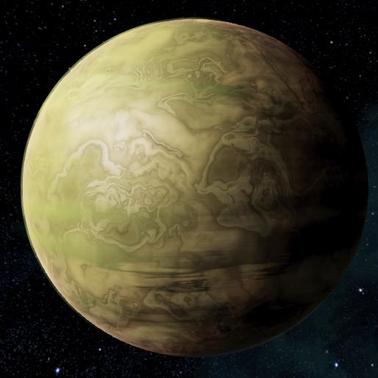
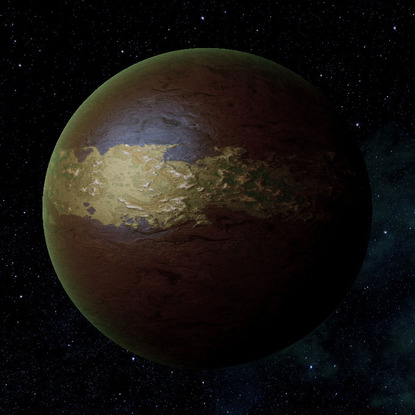
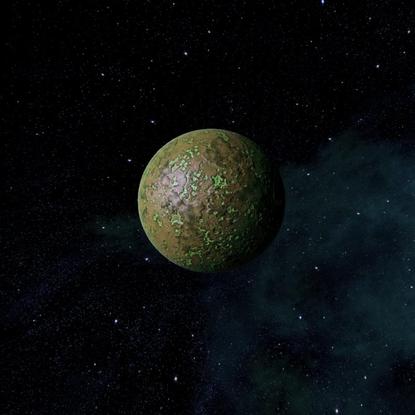
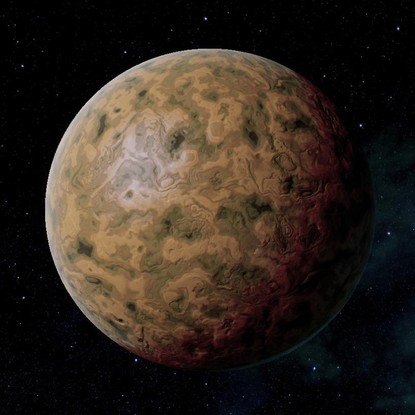
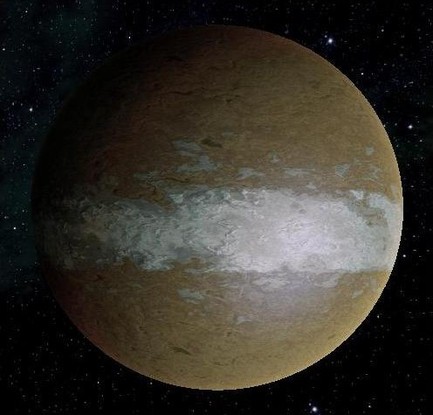
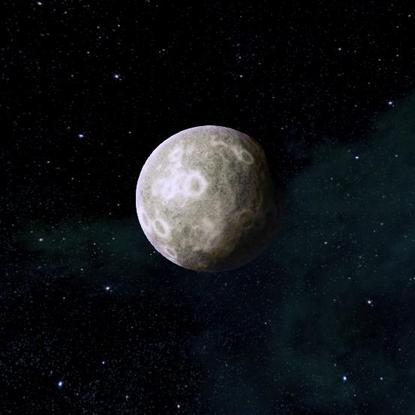
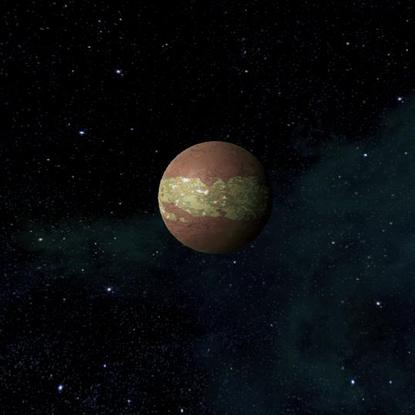
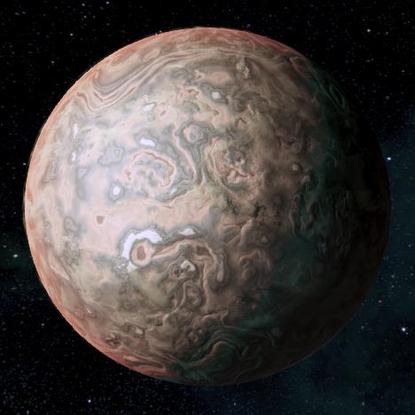
Note
Inv is another signature Inisfreean world; this one appearing as a rich chocolate cake or brownie, spherical, and encircled about its equatorial region with a band of sheen which appears golden-drab in the light, and then holographically deep-green into the dark of night. These are Inv's dirt colors.
Don't let the lime-green haze of the atmospheric distortion at Inv's horizon fool you; this is an Inisfreean 'atmo-forming' technique utilizing ions and next-gen' HAARP for coloration.
Inv is another signature Inisfreean world; this one appearing as a rich chocolate cake or brownie, spherical, and encircled about its equatorial region with a band of sheen which appears golden-drab in the light, and then holographically deep-green into the dark of night. These are Inv's dirt colors.
Don't let the lime-green haze of the atmospheric distortion at Inv's horizon fool you; this is an Inisfreean 'atmo-forming' technique utilizing ions and next-gen' HAARP for coloration.
---[Population Density]---
Earth-That-Was had notorious congestion and urban sprawl, despite less than 2% of its land mass being developed with what the humans called 'civilization'. All Inisfreean worlds use their 'Multiplication Table' to ensure every piece of civilization they build is spread out enough, and covered in biotecture and landscaping enough, so that no more than 100 people ever occupy the same square kilometer. Thus, even though Inisfreean worlds all have 100 billion Inisfreeans living on them and in their hollow cores (more than 14 times the maximum population of Earth-That-Was during 2012), you almost never see or hear any of them, and almost never notice their structures (the majority of which are subterranean); tastefully hidden.
Earth-That-Was had notorious congestion and urban sprawl, despite less than 2% of its land mass being developed with what the humans called 'civilization'. All Inisfreean worlds use their 'Multiplication Table' to ensure every piece of civilization they build is spread out enough, and covered in biotecture and landscaping enough, so that no more than 100 people ever occupy the same square kilometer. Thus, even though Inisfreean worlds all have 100 billion Inisfreeans living on them and in their hollow cores (more than 14 times the maximum population of Earth-That-Was during 2012), you almost never see or hear any of them, and almost never notice their structures (the majority of which are subterranean); tastefully hidden.
---[Inisfree-city Compared to Inisfreean Cities on these Worlds]---
Inisfree (the city) is a mobile, spherical city roughly 1,000 cubic kilometers in volume. It exists in its own dimensional pocket, which is part of its natural state. In contrast, the thousands of Inisfreean cities on each of these hundreds of worlds in star-system Auzdein have clear similarities and differences compared to Inisfree-city, the 'Fertile Crescent' equivalent of the Inisfreean civilization and empire.
For example, the cities of these worlds, like Inisfree-city, are predominantly concealed under ground and landscaping. Unlike Inisfree-city, however, they do not exist in their own dimensional pockets, and are not mobile; either would be unnecessary because their star-system exists in its own dimensional pocket, it is mobile (it can be piloted/flown anywhere in Creation), and because earthquakes and 'natural disasters' are not possible on any of its worlds, thus there is no need for large Repulsine assistance.
Inisfree (the city) is a mobile, spherical city roughly 1,000 cubic kilometers in volume. It exists in its own dimensional pocket, which is part of its natural state. In contrast, the thousands of Inisfreean cities on each of these hundreds of worlds in star-system Auzdein have clear similarities and differences compared to Inisfree-city, the 'Fertile Crescent' equivalent of the Inisfreean civilization and empire.
For example, the cities of these worlds, like Inisfree-city, are predominantly concealed under ground and landscaping. Unlike Inisfree-city, however, they do not exist in their own dimensional pockets, and are not mobile; either would be unnecessary because their star-system exists in its own dimensional pocket, it is mobile (it can be piloted/flown anywhere in Creation), and because earthquakes and 'natural disasters' are not possible on any of its worlds, thus there is no need for large Repulsine assistance.
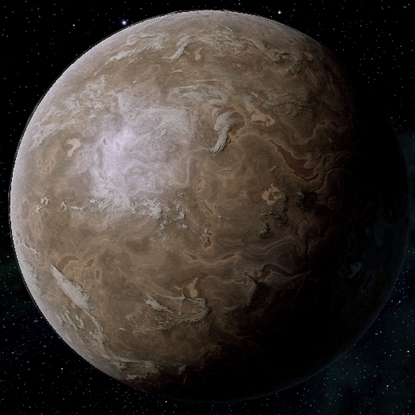
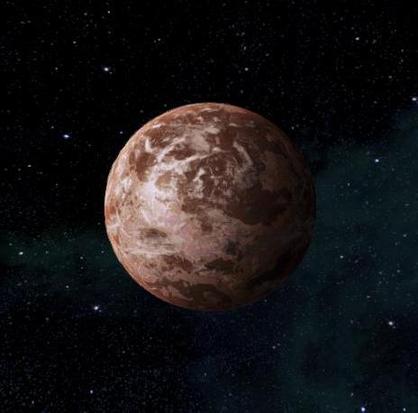
Auzdein (2517) 2L3
M
6,500 km
1.0 Earth Masses
(N/A) #.##
N/A
115 - -15 °F
1.0 g
1.00 atm
.41 AU
.41 EY; 150 days
24.0 Earth Hours
Yes; 2517
No; (ideal from start)
Population:
Capital:
100,000,000,000
Inisfree (city)
Yes; 2517
No; (ideal from start)
Population:
Capital:
100,000,000,000
Inisfree (city)
100,000,000,000
Inisfree (city)
Yes; 2517
No; (ideal from start)
Population:
Capital:
Population:
Capital:
Yes; 2517
No; (ideal from start)
100,000,000,000
Inisfree (city)
100,000,000,000
Inisfree (city)
Yes; 2517
No; (ideal from start)
Population:
Capital:
Population:
Capital:
Yes; 2517
No; (ideal from start)
100,000,000,000
Inisfree (city)
100,000,000,000
Inisfree (city)
Yes; 2517
No; (ideal from start)
Population:
Capital:
Population:
Capital:
Yes; 2517
No; (ideal from start)
100,000,000,000
Inisfree (city)
100,000,000,000
Inisfree (city)
Yes; 2517
No; (ideal from start)
Population:
Capital:
Population:
Capital:
Yes; 2517
No; (ideal from start)
100,000,000,000
Inisfree (city)
100,000,000,000
Inisfree (city)
Yes; 2517
No; (ideal from start)
Population:
Capital:
Population:
Capital:
Yes; 2517
No; (ideal from start)
100,000,000,000
Inisfree (city)
100,000,000,000
Inisfree (city)
Yes; 2517
No; (ideal from start)
Population:
Capital:
Population:
Capital:
Yes; 2517
No; (ideal from start)
100,000,000,000
Inisfree (city)
Population:
Capital:
Yes; 2517
No; (ideal from start)
100,000,000,000
Inisfree (city)
100,000,000,000
Inisfree (city)
Yes; 2517
No; (ideal from start)
Population:
Capital:
Population:
Capital:
Yes; 2517
No; (ideal from start)
100,000,000,000
Inisfree (city)
100,000,000,000
Inisfree (city)
Yes; 2517
No; (ideal from start)
Population:
Capital:
Population:
Capital:
Yes; 2517
No; (ideal from start)
100,000,000,000
Inisfree (city)
100,000,000,000
Inisfree (city)
Yes; 2517
No; (ideal from start)
Population:
Capital:
Population:
Capital:
Yes; 2517
No; (ideal from start)
100,000,000,000
Inisfree (city)
100,000,000,000
Inisfree (city)
Yes; 2517
No; (ideal from start)
Population:
Capital:
Population:
Capital:
Yes; 2517
No; (ideal from start)
100,000,000,000
Inisfree (city)
Auzdein (2517) 2L4
M
6,500 km
1.0 Earth Masses
(N/A) #.##
N/A
115 - -15 °F
1.0 g
1.00 atm
.41 AU
.41 EY; 150 days
24.0 Earth Hours
Auzdein (2517) 2L5
M
6,500 km
1.0 Earth Masses
(N/A) #.##
N/A
115 - -15 °F
1.0 g
1.00 atm
.41 AU
.41 EY; 150 days
24.0 Earth Hours
Auzdein (2517) 2L1
M
6,500 km
1.0 Earth Masses
(N/A) #.##
N/A
115 - -15 °F
1.0 g
1.00 atm
.41 AU
.41 EY; 150 days
24.0 Earth Hours
Auzdein (2517) 2L2
M
6,500 km
1.0 Earth Masses
(N/A) #.##
N/A
115 - -15 °F
1.0 g
1.00 atm
.41 AU
.41 EY; 150 days
24.0 Earth Hours
Auzdein (2517) 2L3M
M
6,500 km
1.0 Earth Masses
(N/A) #.##
N/A
115 - -15 °F
1.0 g
1.00 atm
.41 AU
30 Earth Days
24.0 Earth Hours
Auzdein (2517) 2L4M
M
6,500 km
1.0 Earth Masses
(N/A) #.##
N/A
115 - -15 °F
1.0 g
1.00 atm
.41 AU
30 Earth Days
24.0 Earth Hours
Auzdein (2517) 2L5M
M
6,500 km
1.0 Earth Masses
(N/A) #.##
N/A
115 - -15 °F
1.0 g
1.00 atm
.41 AU
30 Earth Days
24.0 Earth Hours

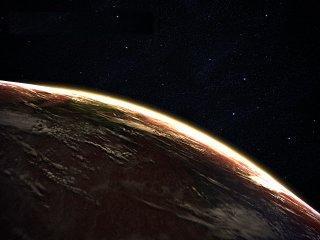

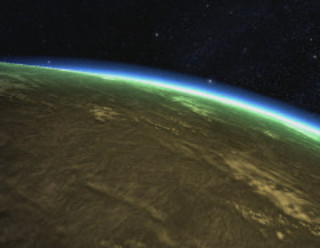
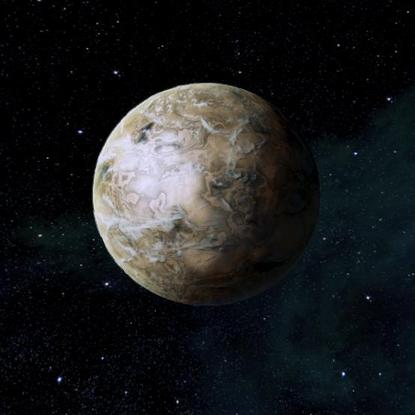
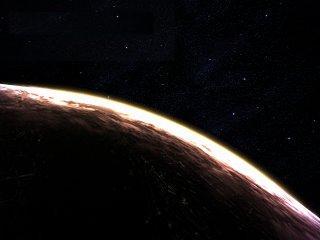
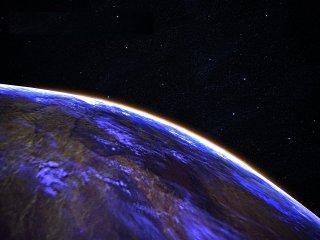
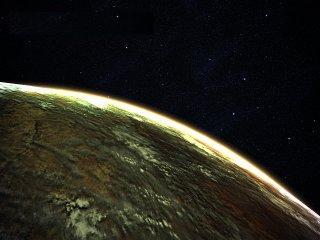

Major Regions
Continents
Continent
Cities:
(thousands)
Oceans
Ocean
Cities:
(floating/submarine)
(thousands)
Continent
Cities:
(thousands)
Oceans
Ocean
Cities:
(floating/submarine)
(thousands)
D = Destroyed / ruins
(thousands; training)
(thousands; training)
Albums
Photos
x
x
Videos
x
x
x
x
Videos
x
x
C = Classified
Albums
Photos
x
x
Videos
x
x
x
x
Videos
x
x
C = Classified
Major Regions
Continents
Continent
Cities:
(thousands)
Oceans
Ocean
Cities:
(floating/submarine)
(thousands)
Continent
Cities:
(thousands)
Oceans
Ocean
Cities:
(floating/submarine)
(thousands)
D = Destroyed / ruins
(thousands; training)
(thousands; training)
Major Regions
Continents
Continent
Cities:
(thousands)
Oceans
Ocean
Cities:
(floating/submarine)
(thousands)
Continent
Cities:
(thousands)
Oceans
Ocean
Cities:
(floating/submarine)
(thousands)
D = Destroyed / ruins
(thousands; training)
(thousands; training)
Albums
Photos
x
x
Videos
x
x
x
x
Videos
x
x
C = Classified


Note
Ori, occupying this innermost solar-orbit’s 4th Lagrangian point, is remarkably Earth-like in its biome diversity and climate orientation; its key difference being (other than that it orbits inside its star) that Ori, like the world named ‘Are’, has its own mini-nebula.
Ori, occupying this innermost solar-orbit’s 4th Lagrangian point, is remarkably Earth-like in its biome diversity and climate orientation; its key difference being (other than that it orbits inside its star) that Ori, like the world named ‘Are’, has its own mini-nebula.
Note
Samn, the L5 planet of this shared orbit, is a world with a very unique terrain consistency; like the ‘smart’-structures of Inisfree-city, Samn’s terrain is semi-cushiony. Whether traversing laterally or vertically, and regardless of being on dunes, crags, or salt-flats, the landscapes of Samn, down to its tiniest pebbles, and up to its most titanic boulders, are all fleshy to the touch.
Samn, the L5 planet of this shared orbit, is a world with a very unique terrain consistency; like the ‘smart’-structures of Inisfree-city, Samn’s terrain is semi-cushiony. Whether traversing laterally or vertically, and regardless of being on dunes, crags, or salt-flats, the landscapes of Samn, down to its tiniest pebbles, and up to its most titanic boulders, are all fleshy to the touch.

Albums
Photos
x
x
Videos
x
x
x
x
Videos
x
x
C = Classified
Major Regions
Continents
Continent
Cities:
(thousands)
Oceans
Ocean
Cities:
(floating/submarine)
(thousands)
Continent
Cities:
(thousands)
Oceans
Ocean
Cities:
(floating/submarine)
(thousands)
D = Destroyed / ruins
(thousands; training)
(thousands; training)

Major Regions
Continents
Continent
Cities:
(thousands)
Oceans
Ocean
Cities:
(floating/submarine)
(thousands)
Continent
Cities:
(thousands)
Oceans
Ocean
Cities:
(floating/submarine)
(thousands)
D = Destroyed / ruins
(thousands; training)
(thousands; training)
Albums
Photos
x
x
Videos
x
x
x
x
Videos
x
x
C = Classified
Albums
Photos
x
x
Videos
x
x
x
x
Videos
x
x
C = Classified

Major Regions
Continents
Continent
Cities:
(thousands)
Oceans
Ocean
Cities:
(floating/submarine)
(thousands)
Continent
Cities:
(thousands)
Oceans
Ocean
Cities:
(floating/submarine)
(thousands)
D = Destroyed / ruins
(thousands; training)
(thousands; training)
Albums
Photos
x
x
Videos
x
x
x
x
Videos
x
x
C = Classified

Major Regions
Continents
Continent
Cities:
(thousands)
Oceans
Ocean
Cities:
(floating/submarine)
(thousands)
Continent
Cities:
(thousands)
Oceans
Ocean
Cities:
(floating/submarine)
(thousands)
D = Destroyed / ruins
(thousands; training)
(thousands; training)

Albums
Photos
x
x
Videos
x
x
x
x
Videos
x
x
C = Classified
Major Regions
Continents
Continent
Cities:
(thousands)
Oceans
Ocean
Cities:
(floating/submarine)
(thousands)
Continent
Cities:
(thousands)
Oceans
Ocean
Cities:
(floating/submarine)
(thousands)
D = Destroyed / ruins
(thousands; training)
(thousands; training)

Major Regions
Continents
Continent
Cities:
(thousands)
Oceans
Ocean
Cities:
(floating/submarine)
(thousands)
Continent
Cities:
(thousands)
Oceans
Ocean
Cities:
(floating/submarine)
(thousands)
D = Destroyed / ruins
(thousands; training)
(thousands; training)
Albums
Photos
x
x
Videos
x
x
x
x
Videos
x
x
C = Classified

Major Regions
Continents
Continent
Cities:
(thousands)
Oceans
Ocean
Cities:
(floating/submarine)
(thousands)
Continent
Cities:
(thousands)
Oceans
Ocean
Cities:
(floating/submarine)
(thousands)
D = Destroyed / ruins
(thousands; training)
(thousands; training)
Albums
Photos
x
x
Videos
x
x
x
x
Videos
x
x
C = Classified
Albums
Photos
x
x
Videos
x
x
x
x
Videos
x
x
C = Classified

Major Regions
Continents
Continent
Cities:
(thousands)
Oceans
Ocean
Cities:
(floating/submarine)
(thousands)
Continent
Cities:
(thousands)
Oceans
Ocean
Cities:
(floating/submarine)
(thousands)
D = Destroyed / ruins
(thousands; training)
(thousands; training)
Major Regions
Continents
Continent
Cities:
(thousands)
Oceans
Ocean
Cities:
(floating/submarine)
(thousands)
Continent
Cities:
(thousands)
Oceans
Ocean
Cities:
(floating/submarine)
(thousands)
D = Destroyed / ruins
(thousands; training)
(thousands; training)

Albums
Photos
x
x
Videos
x
x
x
x
Videos
x
x
C = Classified
Albums
Photos
x
x
Videos
x
x
x
x
Videos
x
x
C = Classified
Major Regions
Continents
Continent
Cities:
(thousands)
Oceans
Ocean
Cities:
(floating/submarine)
(thousands)
Continent
Cities:
(thousands)
Oceans
Ocean
Cities:
(floating/submarine)
(thousands)
D = Destroyed / ruins
(thousands; training)
(thousands; training)

---[Planet Data]---
Stellar ID:
Class:
Radius:
Mass:
Keplerian Ratio:
Stellar ID:
Class:
Radius:
Mass:
Keplerian Ratio:
Luminosity:
Surface Temperature:
Day Length:Surface Temperature:
Surface Gravity:
Atmospheric Pressure:
Atmospheric Pressure:
Orbital Distance:
Orbital Period:
Orbital Period:
---[Status]---
Colonized:
Terraformed:
---[Moons]---
2: Alt, Cho*?
---[Rings]---
0
---[Artificial Satellites]---
0
---[Indigenous]---
Inisfreeans
Colonized:
Terraformed:
---[Moons]---
2: Alt, Cho*?
---[Rings]---
0
---[Artificial Satellites]---
0
---[Indigenous]---
Inisfreeans
---[Moon Data]---
Stellar ID:
Class:
Radius:
Mass:
Keplerian Ratio:
Stellar ID:
Class:
Radius:
Mass:
Keplerian Ratio:
Luminosity:
Surface Temperature:
Day Length:Surface Temperature:
Surface Gravity:
Atmospheric Pressure:
Atmospheric Pressure:
Orbital Distance:
Orbital Period:
Orbital Period:
---[Status]---
Colonized:
Terraformed:
---[Moons]---
0
---[Rings]---
0
---[Artificial Satellites]---
0
---[Indigenous]---
Inisfreeans
Colonized:
Terraformed:
---[Moons]---
0
---[Rings]---
0
---[Artificial Satellites]---
0
---[Indigenous]---
Inisfreeans
Auzdein (2517) 3P
M
6,500 km
1.0 Earth Masses
(N/A) #.##
N/A
110 - -20 °F
1.0 g
1.00 atm
.49 AU
.49 EY; 180 days
24.0 Earth Hours
---[Moon Data]---
Stellar ID:
Class:
Radius:
Mass:
Keplerian Ratio:
Stellar ID:
Class:
Radius:
Mass:
Keplerian Ratio:
Luminosity:
Surface Temperature:
Day Length:Surface Temperature:
Surface Gravity:
Atmospheric Pressure:
Atmospheric Pressure:
Orbital Distance:
Orbital Period:
Orbital Period:
---[Status]---
Colonized:
Terraformed:
---[Moons]---
0
---[Rings]---
0
---[Artificial Satellites]---
0
---[Indigenous]---
Inisfreeans
Colonized:
Terraformed:
---[Moons]---
0
---[Rings]---
0
---[Artificial Satellites]---
0
---[Indigenous]---
Inisfreeans
---[Planet Data]---
Stellar ID:
Class:
Radius:
Mass:
Keplerian Ratio:
Stellar ID:
Class:
Radius:
Mass:
Keplerian Ratio:
Luminosity:
Surface Temperature:
Day Length:Surface Temperature:
Surface Gravity:
Atmospheric Pressure:
Atmospheric Pressure:
Orbital Distance:
Orbital Period:
Orbital Period:
---[Status]---
Colonized:
Terraformed:
---[Moons]---
1: Clo*?
---[Rings]---
0
---[Artificial Satellites]---
0
---[Indigenous]---
Inisfreeans
Colonized:
Terraformed:
---[Moons]---
1: Clo*?
---[Rings]---
0
---[Artificial Satellites]---
0
---[Indigenous]---
Inisfreeans
---[Moon Data]---
Stellar ID:
Class:
Radius:
Mass:
Keplerian Ratio:
Stellar ID:
Class:
Radius:
Mass:
Keplerian Ratio:
Luminosity:
Surface Temperature:
Day Length:Surface Temperature:
Surface Gravity:
Atmospheric Pressure:
Atmospheric Pressure:
Orbital Distance:
Orbital Period:
Orbital Period:
---[Status]---
Colonized:
Terraformed:
---[Moons]---
0
---[Rings]---
0
---[Artificial Satellites]---
0
---[Indigenous]---
Inisfreeans
Colonized:
Terraformed:
---[Moons]---
0
---[Rings]---
0
---[Artificial Satellites]---
0
---[Indigenous]---
Inisfreeans
---[Planet Data]---
Stellar ID:
Class:
Radius:
Mass:
Keplerian Ratio:
Stellar ID:
Class:
Radius:
Mass:
Keplerian Ratio:
Luminosity:
Surface Temperature:
Day Length:Surface Temperature:
Surface Gravity:
Atmospheric Pressure:
Atmospheric Pressure:
Orbital Distance:
Orbital Period:
Orbital Period:
---[Status]---
Colonized:
Terraformed:
---[Moons]---
1: Int
---[Rings]---
0
---[Artificial Satellites]---
0
---[Indigenous]---
Inisfreeans
Colonized:
Terraformed:
---[Moons]---
1: Int
---[Rings]---
0
---[Artificial Satellites]---
0
---[Indigenous]---
Inisfreeans
---[Moon Data]---
Stellar ID:
Class:
Radius:
Mass:
Keplerian Ratio:
Stellar ID:
Class:
Radius:
Mass:
Keplerian Ratio:
Luminosity:
Surface Temperature:
Day Length:Surface Temperature:
Surface Gravity:
Atmospheric Pressure:
Atmospheric Pressure:
Orbital Distance:
Orbital Period:
Orbital Period:
---[Status]---
Colonized:
Terraformed:
---[Moons]---
0
---[Rings]---
0
---[Artificial Satellites]---
0
---[Indigenous]---
Inisfreeans
Colonized:
Terraformed:
---[Moons]---
0
---[Rings]---
0
---[Artificial Satellites]---
0
---[Indigenous]---
Inisfreeans
---[Planet Data]---
Stellar ID:
Class:
Radius:
Mass:
Keplerian Ratio:
Stellar ID:
Class:
Radius:
Mass:
Keplerian Ratio:
Luminosity:
Surface Temperature:
Day Length:Surface Temperature:
Surface Gravity:
Atmospheric Pressure:
Atmospheric Pressure:
Orbital Distance:
Orbital Period:
Orbital Period:
---[Status]---
Colonized:
Terraformed:
---[Moons]---
1: Clo*?
---[Rings]---
0
---[Artificial Satellites]---
0
---[Indigenous]---
Inisfreeans
Colonized:
Terraformed:
---[Moons]---
1: Clo*?
---[Rings]---
0
---[Artificial Satellites]---
0
---[Indigenous]---
Inisfreeans
---[Moon Data]---
Stellar ID:
Class:
Radius:
Mass:
Keplerian Ratio:
Stellar ID:
Class:
Radius:
Mass:
Keplerian Ratio:
Luminosity:
Surface Temperature:
Day Length:Surface Temperature:
Surface Gravity:
Atmospheric Pressure:
Atmospheric Pressure:
Orbital Distance:
Orbital Period:
Orbital Period:
---[Status]---
Colonized:
Terraformed:
---[Moons]---
0
---[Rings]---
0
---[Artificial Satellites]---
0
---[Indigenous]---
Inisfreeans
Colonized:
Terraformed:
---[Moons]---
0
---[Rings]---
0
---[Artificial Satellites]---
0
---[Indigenous]---
Inisfreeans
---[Planet Data]---
Stellar ID:
Class:
Radius:
Mass:
Keplerian Ratio:
Stellar ID:
Class:
Radius:
Mass:
Keplerian Ratio:
Luminosity:
Surface Temperature:
Day Length:Surface Temperature:
Surface Gravity:
Atmospheric Pressure:
Atmospheric Pressure:
Orbital Distance:
Orbital Period:
Orbital Period:
---[Status]---
Colonized:
Terraformed:
---[Moons]---
0
---[Rings]---
0
---[Artificial Satellites]---
0
---[Indigenous]---
Inisfreeans
Colonized:
Terraformed:
---[Moons]---
0
---[Rings]---
0
---[Artificial Satellites]---
0
---[Indigenous]---
Inisfreeans
---[Planet Data]---
Stellar ID:
Class:
Radius:
Mass:
Keplerian Ratio:
Stellar ID:
Class:
Radius:
Mass:
Keplerian Ratio:
Luminosity:
Surface Temperature:
Day Length:Surface Temperature:
Surface Gravity:
Atmospheric Pressure:
Atmospheric Pressure:
Orbital Distance:
Orbital Period:
Orbital Period:
---[Status]---
Colonized:
Terraformed:
---[Moons]---
0
---[Rings]---
0
---[Artificial Satellites]---
0
---[Indigenous]---
Inisfreeans
Colonized:
Terraformed:
---[Moons]---
0
---[Rings]---
0
---[Artificial Satellites]---
0
---[Indigenous]---
Inisfreeans
Auzdein (2517) 4P
M
6,500 km
1.0 Earth Masses
(N/A) #.##
N/A
95 - -35 °F
1.0 g
1.00 atm
.58 AU
.58 EY; 210 days
24.0 Earth Hours
---[Planet Data]---
Stellar ID:
Class:
Radius:
Mass:
Keplerian Ratio:
Stellar ID:
Class:
Radius:
Mass:
Keplerian Ratio:
Luminosity:
Surface Temperature:
Day Length:Surface Temperature:
Surface Gravity:
Atmospheric Pressure:
Atmospheric Pressure:
Orbital Distance:
Orbital Period:
Orbital Period:
---[Status]---
Colonized:
Terraformed:
---[Moons]---
1: Clu
---[Rings]---
0
---[Artificial Satellites]---
0
---[Indigenous]---
Inisfreeans
Colonized:
Terraformed:
---[Moons]---
1: Clu
---[Rings]---
0
---[Artificial Satellites]---
0
---[Indigenous]---
Inisfreeans
---[Moon Data]---
Stellar ID:
Class:
Radius:
Mass:
Keplerian Ratio:
Stellar ID:
Class:
Radius:
Mass:
Keplerian Ratio:
Luminosity:
Surface Temperature:
Day Length:Surface Temperature:
Surface Gravity:
Atmospheric Pressure:
Atmospheric Pressure:
Orbital Distance:
Orbital Period:
Orbital Period:
---[Status]---
Colonized:
Terraformed:
---[Moons]---
0
---[Rings]---
0
---[Artificial Satellites]---
0
---[Indigenous]---
Inisfreeans
Colonized:
Terraformed:
---[Moons]---
0
---[Rings]---
0
---[Artificial Satellites]---
0
---[Indigenous]---
Inisfreeans
---[Planet Data]---
Stellar ID:
Class:
Radius:
Mass:
Keplerian Ratio:
Stellar ID:
Class:
Radius:
Mass:
Keplerian Ratio:
Luminosity:
Surface Temperature:
Day Length:Surface Temperature:
Surface Gravity:
Atmospheric Pressure:
Atmospheric Pressure:
Orbital Distance:
Orbital Period:
Orbital Period:
---[Status]---
Colonized:
Terraformed:
---[Moons]---
1: Mor
---[Rings]---
0
---[Artificial Satellites]---
0
---[Indigenous]---
Inisfreeans
Colonized:
Terraformed:
---[Moons]---
1: Mor
---[Rings]---
0
---[Artificial Satellites]---
0
---[Indigenous]---
Inisfreeans
---[Moon Data]---
Stellar ID:
Class:
Radius:
Mass:
Keplerian Ratio:
Stellar ID:
Class:
Radius:
Mass:
Keplerian Ratio:
Luminosity:
Surface Temperature:
Day Length:Surface Temperature:
Surface Gravity:
Atmospheric Pressure:
Atmospheric Pressure:
Orbital Distance:
Orbital Period:
Orbital Period:
---[Status]---
Colonized:
Terraformed:
---[Moons]---
0
---[Rings]---
0
---[Artificial Satellites]---
0
---[Indigenous]---
Inisfreeans
Colonized:
Terraformed:
---[Moons]---
0
---[Rings]---
0
---[Artificial Satellites]---
0
---[Indigenous]---
Inisfreeans
---[Planet Data]---
Stellar ID:
Class:
Radius:
Mass:
Keplerian Ratio:
Stellar ID:
Class:
Radius:
Mass:
Keplerian Ratio:
Luminosity:
Surface Temperature:
Day Length:Surface Temperature:
Surface Gravity:
Atmospheric Pressure:
Atmospheric Pressure:
Orbital Distance:
Orbital Period:
Orbital Period:
---[Status]---
Colonized:
Terraformed:
---[Moons]---
1: Der
---[Rings]---
0
---[Artificial Satellites]---
0
---[Indigenous]---
Inisfreeans
Colonized:
Terraformed:
---[Moons]---
1: Der
---[Rings]---
0
---[Artificial Satellites]---
0
---[Indigenous]---
Inisfreeans
---[Moon Data]---
Stellar ID:
Class:
Radius:
Mass:
Keplerian Ratio:
Stellar ID:
Class:
Radius:
Mass:
Keplerian Ratio:
Luminosity:
Surface Temperature:
Day Length:Surface Temperature:
Surface Gravity:
Atmospheric Pressure:
Atmospheric Pressure:
Orbital Distance:
Orbital Period:
Orbital Period:
---[Status]---
Colonized:
Terraformed:
---[Moons]---
0
---[Rings]---
0
---[Artificial Satellites]---
0
---[Indigenous]---
Inisfreeans
Colonized:
Terraformed:
---[Moons]---
0
---[Rings]---
0
---[Artificial Satellites]---
0
---[Indigenous]---
Inisfreeans
---[Planet Data]---
Stellar ID:
Class:
Radius:
Mass:
Keplerian Ratio:
Stellar ID:
Class:
Radius:
Mass:
Keplerian Ratio:
Luminosity:
Surface Temperature:
Day Length:Surface Temperature:
Surface Gravity:
Atmospheric Pressure:
Atmospheric Pressure:
Orbital Distance:
Orbital Period:
Orbital Period:
---[Status]---
Colonized:
Terraformed:
---[Moons]---
1: Gre
---[Rings]---
0
---[Artificial Satellites]---
0
---[Indigenous]---
Inisfreeans
Colonized:
Terraformed:
---[Moons]---
1: Gre
---[Rings]---
0
---[Artificial Satellites]---
0
---[Indigenous]---
Inisfreeans
---[Moon Data]---
Stellar ID:
Class:
Radius:
Mass:
Keplerian Ratio:
Stellar ID:
Class:
Radius:
Mass:
Keplerian Ratio:
Luminosity:
Surface Temperature:
Day Length:Surface Temperature:
Surface Gravity:
Atmospheric Pressure:
Atmospheric Pressure:
Orbital Distance:
Orbital Period:
Orbital Period:
---[Status]---
Colonized:
Terraformed:
---[Moons]---
0
---[Rings]---
0
---[Artificial Satellites]---
0
---[Indigenous]---
Inisfreeans
Colonized:
Terraformed:
---[Moons]---
0
---[Rings]---
0
---[Artificial Satellites]---
0
---[Indigenous]---
Inisfreeans
---[Planet Data]---
Stellar ID:
Class:
Radius:
Mass:
Keplerian Ratio:
Stellar ID:
Class:
Radius:
Mass:
Keplerian Ratio:
Luminosity:
Surface Temperature:
Day Length:Surface Temperature:
Surface Gravity:
Atmospheric Pressure:
Atmospheric Pressure:
Orbital Distance:
Orbital Period:
Orbital Period:
---[Status]---
Colonized:
Terraformed:
---[Moons]---
0
---[Rings]---
0
---[Artificial Satellites]---
0
---[Indigenous]---
Inisfreeans
Colonized:
Terraformed:
---[Moons]---
0
---[Rings]---
0
---[Artificial Satellites]---
0
---[Indigenous]---
Inisfreeans
---[Planet Data]---
Stellar ID:
Class:
Radius:
Mass:
Keplerian Ratio:
Stellar ID:
Class:
Radius:
Mass:
Keplerian Ratio:
Luminosity:
Surface Temperature:
Day Length:Surface Temperature:
Surface Gravity:
Atmospheric Pressure:
Atmospheric Pressure:
Orbital Distance:
Orbital Period:
Orbital Period:
---[Status]---
Colonized:
Terraformed:
---[Moons]---
0
---[Rings]---
0
---[Artificial Satellites]---
0
---[Indigenous]---
Inisfreeans
Colonized:
Terraformed:
---[Moons]---
0
---[Rings]---
0
---[Artificial Satellites]---
0
---[Indigenous]---
Inisfreeans
---[Planet Data]---
Stellar ID:
Class:
Radius:
Mass:
Keplerian Ratio:
Stellar ID:
Class:
Radius:
Mass:
Keplerian Ratio:
Luminosity:
Surface Temperature:
Day Length:Surface Temperature:
Surface Gravity:
Atmospheric Pressure:
Atmospheric Pressure:
Orbital Distance:
Orbital Period:
Orbital Period:
---[Status]---
Colonized:
Terraformed:
---[Moons]---
1: Nov
---[Rings]---
0
---[Artificial Satellites]---
0
---[Indigenous]---
Inisfreeans
Colonized:
Terraformed:
---[Moons]---
1: Nov
---[Rings]---
0
---[Artificial Satellites]---
0
---[Indigenous]---
Inisfreeans
Auzdein (2517) 5P
M
6,500 km
1.0 Earth Masses
(N/A) #.##
N/A
100 - -30 °F
1.0 g
1.00 atm
.66 AU
.66 EY; 240 days
24.0 Earth Hours
---[Moon Data]---
Stellar ID:
Class:
Radius:
Mass:
Keplerian Ratio:
Stellar ID:
Class:
Radius:
Mass:
Keplerian Ratio:
Luminosity:
Surface Temperature:
Day Length:Surface Temperature:
Surface Gravity:
Atmospheric Pressure:
Atmospheric Pressure:
Orbital Distance:
Orbital Period:
Orbital Period:
---[Status]---
Colonized:
Terraformed:
---[Moons]---
0
---[Rings]---
0
---[Artificial Satellites]---
0
---[Indigenous]---
Inisfreeans
Colonized:
Terraformed:
---[Moons]---
0
---[Rings]---
0
---[Artificial Satellites]---
0
---[Indigenous]---
Inisfreeans
---[Planet Data]---
Stellar ID:
Class:
Radius:
Mass:
Keplerian Ratio:
Stellar ID:
Class:
Radius:
Mass:
Keplerian Ratio:
Luminosity:
Surface Temperature:
Day Length:Surface Temperature:
Surface Gravity:
Atmospheric Pressure:
Atmospheric Pressure:
Orbital Distance:
Orbital Period:
Orbital Period:
---[Status]---
Colonized:
Terraformed:
---[Moons]---
1: Tre*?
---[Rings]---
0
---[Artificial Satellites]---
0
---[Indigenous]---
Inisfreeans
Colonized:
Terraformed:
---[Moons]---
1: Tre*?
---[Rings]---
0
---[Artificial Satellites]---
0
---[Indigenous]---
Inisfreeans
---[Moon Data]---
Stellar ID:
Class:
Radius:
Mass:
Keplerian Ratio:
Stellar ID:
Class:
Radius:
Mass:
Keplerian Ratio:
Luminosity:
Surface Temperature:
Day Length:Surface Temperature:
Surface Gravity:
Atmospheric Pressure:
Atmospheric Pressure:
Orbital Distance:
Orbital Period:
Orbital Period:
---[Status]---
Colonized:
Terraformed:
---[Moons]---
0
---[Rings]---
0
---[Artificial Satellites]---
0
---[Indigenous]---
Inisfreeans
Colonized:
Terraformed:
---[Moons]---
0
---[Rings]---
0
---[Artificial Satellites]---
0
---[Indigenous]---
Inisfreeans
---[Planet Data]---
Stellar ID:
Class:
Radius:
Mass:
Keplerian Ratio:
Stellar ID:
Class:
Radius:
Mass:
Keplerian Ratio:
Luminosity:
Surface Temperature:
Day Length:Surface Temperature:
Surface Gravity:
Atmospheric Pressure:
Atmospheric Pressure:
Orbital Distance:
Orbital Period:
Orbital Period:
---[Status]---
Colonized:
Terraformed:
---[Moons]---
1: Tre*?
---[Rings]---
0
---[Artificial Satellites]---
0
---[Indigenous]---
Inisfreeans
Colonized:
Terraformed:
---[Moons]---
1: Tre*?
---[Rings]---
0
---[Artificial Satellites]---
0
---[Indigenous]---
Inisfreeans
---[Moon Data]---
Stellar ID:
Class:
Radius:
Mass:
Keplerian Ratio:
Stellar ID:
Class:
Radius:
Mass:
Keplerian Ratio:
Luminosity:
Surface Temperature:
Day Length:Surface Temperature:
Surface Gravity:
Atmospheric Pressure:
Atmospheric Pressure:
Orbital Distance:
Orbital Period:
Orbital Period:
---[Status]---
Colonized:
Terraformed:
---[Moons]---
0
---[Rings]---
0
---[Artificial Satellites]---
0
---[Indigenous]---
Inisfreeans
Colonized:
Terraformed:
---[Moons]---
0
---[Rings]---
0
---[Artificial Satellites]---
0
---[Indigenous]---
Inisfreeans
---[Planet Data]---
Stellar ID:
Class:
Radius:
Mass:
Keplerian Ratio:
Stellar ID:
Class:
Radius:
Mass:
Keplerian Ratio:
Luminosity:
Surface Temperature:
Day Length:Surface Temperature:
Surface Gravity:
Atmospheric Pressure:
Atmospheric Pressure:
Orbital Distance:
Orbital Period:
Orbital Period:
---[Status]---
Colonized:
Terraformed:
---[Moons]---
1: Ter
---[Rings]---
0
---[Artificial Satellites]---
0
---[Indigenous]---
Inisfreeans
Colonized:
Terraformed:
---[Moons]---
1: Ter
---[Rings]---
0
---[Artificial Satellites]---
0
---[Indigenous]---
Inisfreeans
---[Moon Data]---
Stellar ID:
Class:
Radius:
Mass:
Keplerian Ratio:
Stellar ID:
Class:
Radius:
Mass:
Keplerian Ratio:
Luminosity:
Surface Temperature:
Day Length:Surface Temperature:
Surface Gravity:
Atmospheric Pressure:
Atmospheric Pressure:
Orbital Distance:
Orbital Period:
Orbital Period:
---[Status]---
Colonized:
Terraformed:
---[Moons]---
0
---[Rings]---
0
---[Artificial Satellites]---
0
---[Indigenous]---
Inisfreeans
Colonized:
Terraformed:
---[Moons]---
0
---[Rings]---
0
---[Artificial Satellites]---
0
---[Indigenous]---
Inisfreeans
---[Planet Data]---
Stellar ID:
Class:
Radius:
Mass:
Keplerian Ratio:
Stellar ID:
Class:
Radius:
Mass:
Keplerian Ratio:
Luminosity:
Surface Temperature:
Day Length:Surface Temperature:
Surface Gravity:
Atmospheric Pressure:
Atmospheric Pressure:
Orbital Distance:
Orbital Period:
Orbital Period:
---[Status]---
Colonized:
Terraformed:
---[Moons]---
0
---[Rings]---
0
---[Artificial Satellites]---
0
---[Indigenous]---
Inisfreeans
Colonized:
Terraformed:
---[Moons]---
0
---[Rings]---
0
---[Artificial Satellites]---
0
---[Indigenous]---
Inisfreeans
---[Planet Data]---
Stellar ID:
Class:
Radius:
Mass:
Keplerian Ratio:
Stellar ID:
Class:
Radius:
Mass:
Keplerian Ratio:
Luminosity:
Surface Temperature:
Day Length:Surface Temperature:
Surface Gravity:
Atmospheric Pressure:
Atmospheric Pressure:
Orbital Distance:
Orbital Period:
Orbital Period:
---[Status]---
Colonized:
Terraformed:
---[Moons]---
0
---[Rings]---
0
---[Artificial Satellites]---
0
---[Indigenous]---
Inisfreeans
Colonized:
Terraformed:
---[Moons]---
0
---[Rings]---
0
---[Artificial Satellites]---
0
---[Indigenous]---
Inisfreeans
---[Star-system Auzdein]---
Continued on:
Page 2 of 4: Here
(Solar Orbits 6-10, inclusive)
Page 3 of 4: Here
(Solar Orbits 11-15, inclusive)
Page 4 of 4: Here
(Solar Orbit 16; Gas-giants)
Continued on:
Page 2 of 4: Here
(Solar Orbits 6-10, inclusive)
Page 3 of 4: Here
(Solar Orbits 11-15, inclusive)
Page 4 of 4: Here
(Solar Orbit 16; Gas-giants)
Auzdein (2517) 3PM
M
6,500 km
1.0 Earth Masses
(N/A) #.##
N/A
110 - -20 °F
1.0 g
1.00 atm
.49 AU
30 Earth Days
24.0 Earth Hours
Auzdein (2517) 4PM
M
6,500 km
1.0 Earth Masses
(N/A) #.##
N/A
95 - -35 °F
1.0 g
1.00 atm
.58 AU
30 Earth Days
24.0 Earth Hours
Auzdein (2517) 5PM
M
6,500 km
1.0 Earth Masses
(N/A) #.##
N/A
100 - -30 °F
1.0 g
1.00 atm
.66 AU
30 Earth Days
24.0 Earth Hours
Albums
Photos
x
x
Videos
x
x
x
x
Videos
x
x
C = Classified
Note
Min is a planet whose grasslands are partially airborne; some of them floating in the skies upon clumps and islands of soils and rocks which are significantly naturally repellent to the rest of Min's outer surface. The result are many cloud formations which appear to transition back and forth between light grays and lime greens; especially attention grabbing when noticed out over the otherwise normal-looking oceans.
Min is a planet whose grasslands are partially airborne; some of them floating in the skies upon clumps and islands of soils and rocks which are significantly naturally repellent to the rest of Min's outer surface. The result are many cloud formations which appear to transition back and forth between light grays and lime greens; especially attention grabbing when noticed out over the otherwise normal-looking oceans.
最小值
Min
Major Regions
Continents
Continent
Cities:
(thousands)
Oceans
Ocean
Cities:
(floating/submarine)
(thousands)
Continent
Cities:
(thousands)
Oceans
Ocean
Cities:
(floating/submarine)
(thousands)
D = Destroyed / ruins
(thousands; training)
(thousands; training)


Major Regions
Continents
Continent
Cities:
(thousands)
Oceans
Ocean
Cities:
(floating/submarine)
(thousands)
Continent
Cities:
(thousands)
Oceans
Ocean
Cities:
(floating/submarine)
(thousands)
D = Destroyed / ruins
(thousands; training)
(thousands; training)
Albums
Photos
x
x
Videos
x
x
x
x
Videos
x
x
C = Classified
Note
Ter is a moon with a rather unique bioluminescence; after nightfall, a few of its grass types begin to glow, but only subtly, and often amidst -or partially covered by- other grass types in the same areas. This produces a soft, dim, golden-brown 'freckling' randomly spread out across several of this moon's continents.
As with other Inisfreean worlds of darker bedrocks, Ter's oceans appear much deeper and Earth-like than they are.
Ter is a moon with a rather unique bioluminescence; after nightfall, a few of its grass types begin to glow, but only subtly, and often amidst -or partially covered by- other grass types in the same areas. This produces a soft, dim, golden-brown 'freckling' randomly spread out across several of this moon's continents.
As with other Inisfreean worlds of darker bedrocks, Ter's oceans appear much deeper and Earth-like than they are.
Ter
之三

Major Regions
Continents
Continent
Cities:
(thousands)
Oceans
Ocean
Cities:
(floating/submarine)
(thousands)
Continent
Cities:
(thousands)
Oceans
Ocean
Cities:
(floating/submarine)
(thousands)
D = Destroyed / ruins
(thousands; training)
(thousands; training)
Albums
Photos
x
x
Videos
x
x
x
x
Videos
x
x
C = Classified
Note
Lightest in color of most Inisfreean worlds, Sid is a planet with almost all white and palest sky blue grasses. Its few bodies of water are in deep pits and canyons, only two of which are wide enough to be considered long lakes.
Sid's only major, pronounced change in elevation is between two of these canyons running almost parallel with one another, visible from this photo's orbital position as a diagonal strip of land over the center of the right hemisphere.
Lightest in color of most Inisfreean worlds, Sid is a planet with almost all white and palest sky blue grasses. Its few bodies of water are in deep pits and canyons, only two of which are wide enough to be considered long lakes.
Sid's only major, pronounced change in elevation is between two of these canyons running almost parallel with one another, visible from this photo's orbital position as a diagonal strip of land over the center of the right hemisphere.
Sid
希德
Major Regions
Continents
Continent
Cities:
(thousands)
Oceans
Ocean
Cities:
(floating/submarine)
(thousands)
Continent
Cities:
(thousands)
Oceans
Ocean
Cities:
(floating/submarine)
(thousands)
D = Destroyed / ruins
(thousands; training)
(thousands; training)
Albums
Photos
x
x
Videos
x
x
x
x
Videos
x
x
C = Classified
Note
Roth's moon is covered in dark aquamarine, dark teal, dark lavender, and even ultramarine and greenish royal or navy blue grasses. With few mountains, this world's distinguishing outer surface features are its jagged ravines separating its continent-sized plateaus into collections of land-locked peninsulas.
Roth's moon is covered in dark aquamarine, dark teal, dark lavender, and even ultramarine and greenish royal or navy blue grasses. With few mountains, this world's distinguishing outer surface features are its jagged ravines separating its continent-sized plateaus into collections of land-locked peninsulas.
Trea
待遇
Albums
Photos
x
x
Videos
x
x
x
x
Videos
x
x
C = Classified
Note
Planet Roth is a true global grassland, with its thin, tiny greenery reaching all the way up to the tops of its generally snow-free mountains, sometimes changing in color from greens to pale browns. Lower regions with darker soils or more hidden surface waters appear thicker and darker shades of green, but this can also be due to mere grass blade coloration as high up as many of this world's mountains reach.
Planet Roth is a true global grassland, with its thin, tiny greenery reaching all the way up to the tops of its generally snow-free mountains, sometimes changing in color from greens to pale browns. Lower regions with darker soils or more hidden surface waters appear thicker and darker shades of green, but this can also be due to mere grass blade coloration as high up as many of this world's mountains reach.
Major Regions
Continents
Continent
Cities:
(thousands)
Oceans
Ocean
Cities:
(floating/submarine)
(thousands)
Continent
Cities:
(thousands)
Oceans
Ocean
Cities:
(floating/submarine)
(thousands)
D = Destroyed / ruins
(thousands; training)
(thousands; training)
Roth
羅斯
Major Regions
Continents
Continent
Cities:
(thousands)
Oceans
Ocean
Cities:
(floating/submarine)
(thousands)
Continent
Cities:
(thousands)
Oceans
Ocean
Cities:
(floating/submarine)
(thousands)
D = Destroyed / ruins
(thousands; training)
(thousands; training)
Albums
Photos
x
x
Videos
x
x
x
x
Videos
x
x
C = Classified
Note
One of the darkest Inisfreean worlds in terms of outward appearances, this moon's bedrock, soils, and grasses are all of the earth tones, greens, and grays closest to charcoal and soot, if not also black. Only the bodies of water give this moon its welcoming colors, but even though they are traditionally (for Inisfreean terraforming) shallow lakes and ponds, their dark beds and floors make them appear as the deepest oceans and trenches.
One of the darkest Inisfreean worlds in terms of outward appearances, this moon's bedrock, soils, and grasses are all of the earth tones, greens, and grays closest to charcoal and soot, if not also black. Only the bodies of water give this moon its welcoming colors, but even though they are traditionally (for Inisfreean terraforming) shallow lakes and ponds, their dark beds and floors make them appear as the deepest oceans and trenches.
Trem
湯瑪斯
Major Regions
Continents
Continent
Cities:
(thousands)
Oceans
Ocean
Cities:
(floating/submarine)
(thousands)
Continent
Cities:
(thousands)
Oceans
Ocean
Cities:
(floating/submarine)
(thousands)
D = Destroyed / ruins
(thousands; training)
(thousands; training)
Albums
Photos
x
x
Videos
x
x
x
x
Videos
x
x
C = Classified
Note
Orbiting exactly opposite the primary planet in this 5th solar orbit (on the other side of this system's central group of stars) is a world of of highly varied topography; a global outer surface of ravines and box-canyons, and a northern polar region so 'wrinkled' that navigation by land is next to impossible. The grasses of this planet range in color from sky blue, steel blue, cornflower blue, and teal... to shale, slate, and pale smoke. This makes distinguishing bodies of water from orbit a feat for the naked eye.
Orbiting exactly opposite the primary planet in this 5th solar orbit (on the other side of this system's central group of stars) is a world of of highly varied topography; a global outer surface of ravines and box-canyons, and a northern polar region so 'wrinkled' that navigation by land is next to impossible. The grasses of this planet range in color from sky blue, steel blue, cornflower blue, and teal... to shale, slate, and pale smoke. This makes distinguishing bodies of water from orbit a feat for the naked eye.
Theg
的
Major Regions
Continents
Continent
Cities:
(thousands)
Oceans
Ocean
Cities:
(floating/submarine)
(thousands)
Continent
Cities:
(thousands)
Oceans
Ocean
Cities:
(floating/submarine)
(thousands)
D = Destroyed / ruins
(thousands; training)
(thousands; training)
Albums
Photos
x
x
Videos
x
x
x
x
Videos
x
x
C = Classified
Note
Another initially visually deceptive world, Nov is a moon appearing as a Class O world; one covered in water. As one draws nearer its surface, however, it becomes clear (pun!) that the majority of its 'waves' are the bending of its grassland blades by the winds. Reddish-brown grassland regions create a 'blush' on this lunar face, and a global assortment of tiny lakes and watering holes further enhance this striking and signature coloration.
Another initially visually deceptive world, Nov is a moon appearing as a Class O world; one covered in water. As one draws nearer its surface, however, it becomes clear (pun!) that the majority of its 'waves' are the bending of its grassland blades by the winds. Reddish-brown grassland regions create a 'blush' on this lunar face, and a global assortment of tiny lakes and watering holes further enhance this striking and signature coloration.
Nov
月
Major Regions
Continents
Continent
Cities:
(thousands)
Oceans
Ocean
Cities:
(floating/submarine)
(thousands)
Continent
Cities:
(thousands)
Oceans
Ocean
Cities:
(floating/submarine)
(thousands)
D = Destroyed / ruins
(thousands; training)
(thousands; training)
Albums
Photos
x
x
Videos
x
x
x
x
Videos
x
x
C = Classified
Note
Ein appears to be a global jungle, however, upon closer inspection, this planet is one of the 5th solar orbit's grassland worlds. The reason for this is that, though this orbit is a bit farther from the group of stars at this system's center, it is also one of the solar orbits closest to the asteroid belt; a collection of not only asteroids, but brown dwarf stars giving off enough heat to keep solar orbits 4 through 6 almost as warm as orbit 3. Even in Ein's equatorial trench region, only thick grasses grow -all the way up near its mountain peaks.
Ein appears to be a global jungle, however, upon closer inspection, this planet is one of the 5th solar orbit's grassland worlds. The reason for this is that, though this orbit is a bit farther from the group of stars at this system's center, it is also one of the solar orbits closest to the asteroid belt; a collection of not only asteroids, but brown dwarf stars giving off enough heat to keep solar orbits 4 through 6 almost as warm as orbit 3. Even in Ein's equatorial trench region, only thick grasses grow -all the way up near its mountain peaks.
Ein
在中
Major Regions
Continents
Continent
Cities:
(thousands)
Oceans
Ocean
Cities:
(floating/submarine)
(thousands)
Continent
Cities:
(thousands)
Oceans
Ocean
Cities:
(floating/submarine)
(thousands)
D = Destroyed / ruins
(thousands; training)
(thousands; training)
Albums
Photos
x
x
Videos
x
x
x
x
Videos
x
x
C = Classified
Note
Tun is a planet whose savannahs appear superimposed across a global landscape almost 1/3 composed of virtually countless standalone mountains. With no distinguishable ridgelines to speak of, these partially radial, partially random arrangements make orienting particularly challenging to any visitor not connected to the I.N.N. (Inisfreean Neural Network; the next-gen' version of the Ansible) or, at least, equipped with a compass (a GPS device would be useless on any Inisfreean world, as none of them have such satellites; obsolete tech').
Tun is a planet whose savannahs appear superimposed across a global landscape almost 1/3 composed of virtually countless standalone mountains. With no distinguishable ridgelines to speak of, these partially radial, partially random arrangements make orienting particularly challenging to any visitor not connected to the I.N.N. (Inisfreean Neural Network; the next-gen' version of the Ansible) or, at least, equipped with a compass (a GPS device would be useless on any Inisfreean world, as none of them have such satellites; obsolete tech').
Tun
敦

Albums
Photos
x
x
Videos
x
x
x
x
Videos
x
x
C = Classified
Major Regions
Continents
Continent
Cities:
(thousands)
Oceans
Ocean
Cities:
(floating/submarine)
(thousands)
Continent
Cities:
(thousands)
Oceans
Ocean
Cities:
(floating/submarine)
(thousands)
D = Destroyed / ruins
(thousands; training)
(thousands; training)
Note
This planet's savannahs are, like on a few other worlds in this solar orbit, isolated, continent-sized regions. The spaces in between them are reddish soils much like what was once found in Oklahoma and in the Outback of Australia on Earth-That-Was.
This planet's savannahs are, like on a few other worlds in this solar orbit, isolated, continent-sized regions. The spaces in between them are reddish soils much like what was once found in Oklahoma and in the Outback of Australia on Earth-That-Was.
Inta
國家航
Major Regions
Continents
Continent
Cities:
(thousands)
Oceans
Ocean
Cities:
(floating/submarine)
(thousands)
Continent
Cities:
(thousands)
Oceans
Ocean
Cities:
(floating/submarine)
(thousands)
D = Destroyed / ruins
(thousands; training)
(thousands; training)

Albums
Photos
x
x
Videos
x
x
x
x
Videos
x
x
C = Classified
Note
Gre's savannahs are nocturnally bioluminescent, much like the urban trees of Inisfree's inner-city called Sotu; when night falls, unless the aurora is especially bright (stimulating this world's plantlife's photocells as daylight would), Gre appears to twinkle to life, misleading the approaching onlookers who might, upon first orbital entry, think these specks of light to be indicative of the electrically illuminated dots of civilization they are accustomed to from the Outlands.
Gre's savannahs are nocturnally bioluminescent, much like the urban trees of Inisfree's inner-city called Sotu; when night falls, unless the aurora is especially bright (stimulating this world's plantlife's photocells as daylight would), Gre appears to twinkle to life, misleading the approaching onlookers who might, upon first orbital entry, think these specks of light to be indicative of the electrically illuminated dots of civilization they are accustomed to from the Outlands.
Gre
灰色

Major Regions
Continents
Continent
Cities:
(thousands)
Oceans
Ocean
Cities:
(floating/submarine)
(thousands)
Continent
Cities:
(thousands)
Oceans
Ocean
Cities:
(floating/submarine)
(thousands)
D = Destroyed / ruins
(thousands; training)
(thousands; training)
Albums
Photos
x
x
Videos
x
x
x
x
Videos
x
x
C = Classified
Note
Ben's savannahs are interrupted by continent-sized regions of dirt and mud, although much flora remains prevalent across all of those regions, as well. What appear to be green seas and oceans are actually some of the smoothest stretches of tree peppered lands in all the Verse. Inisfreean plantlife, after all, is always so healthy that its blades of grass and biggest leaves all always seem to hypnotically sway like healthy, conditioned mops of hair in the slightest of breezes.
Ben's savannahs are interrupted by continent-sized regions of dirt and mud, although much flora remains prevalent across all of those regions, as well. What appear to be green seas and oceans are actually some of the smoothest stretches of tree peppered lands in all the Verse. Inisfreean plantlife, after all, is always so healthy that its blades of grass and biggest leaves all always seem to hypnotically sway like healthy, conditioned mops of hair in the slightest of breezes.
Ben
已

Major Regions
Continents
Continent
Cities:
(thousands)
Oceans
Ocean
Cities:
(floating/submarine)
(thousands)
Continent
Cities:
(thousands)
Oceans
Ocean
Cities:
(floating/submarine)
(thousands)
D = Destroyed / ruins
(thousands; training)
(thousands; training)
Albums
Photos
x
x
Videos
x
x
x
x
Videos
x
x
C = Classified
Note
Der’s savannahs are more obvious; dark green regions indicate the thick and hearty grasses, while the drier and more vacant brown patches indicate the plains and plateaus of warm dirt and mud. Mountain ranges are fairly common on Der; many towering peaks are visible from this orbital vantage, their lighter faces catching the light of Der’s parent-planet, Sar, and revealing their nearly 50 to 60 degree slopes.
Der’s savannahs are more obvious; dark green regions indicate the thick and hearty grasses, while the drier and more vacant brown patches indicate the plains and plateaus of warm dirt and mud. Mountain ranges are fairly common on Der; many towering peaks are visible from this orbital vantage, their lighter faces catching the light of Der’s parent-planet, Sar, and revealing their nearly 50 to 60 degree slopes.
Der
范德

Major Regions
Continents
Continent
Cities:
(thousands)
Oceans
Ocean
Cities:
(floating/submarine)
(thousands)
Continent
Cities:
(thousands)
Oceans
Ocean
Cities:
(floating/submarine)
(thousands)
D = Destroyed / ruins
(thousands; training)
(thousands; training)
Albums
Photos
x
x
Videos
x
x
x
x
Videos
x
x
C = Classified
Note
Sar is covered in palest blue clays and sands; its savannah aspect coming from the many thin ribbons meandering around its outer face, as well as the nation-sized dark patches scattered amongst, and sometimes feeding into these ribbons. These darker patches and ribbons are where the vast majority of Sar’s grasses grow (excluding, of course, the much more heavily vegetated, hollow core). Savannahs do exist across Sar’s pale blue plains of sand and clay, though; the grasses there are just far shorter and more sparsely arranged.
Sar is covered in palest blue clays and sands; its savannah aspect coming from the many thin ribbons meandering around its outer face, as well as the nation-sized dark patches scattered amongst, and sometimes feeding into these ribbons. These darker patches and ribbons are where the vast majority of Sar’s grasses grow (excluding, of course, the much more heavily vegetated, hollow core). Savannahs do exist across Sar’s pale blue plains of sand and clay, though; the grasses there are just far shorter and more sparsely arranged.
Sar
香港特

Major Regions
Continents
Continent
Cities:
(thousands)
Oceans
Ocean
Cities:
(floating/submarine)
(thousands)
Continent
Cities:
(thousands)
Oceans
Ocean
Cities:
(floating/submarine)
(thousands)
D = Destroyed / ruins
(thousands; training)
(thousands; training)
Albums
Photos
x
x
Videos
x
x
x
x
Videos
x
x
C = Classified
Note
Mor, though appearing cool and watery, is actually a typical savannah world of this 4th solar orbit. Large stretches of white and skyblue-colored sands make up entire regions and continent-sized expanses, while the same blue elements keep its more stationary landforms, whether dirt or mud, looking almost like deep oceans. Mor’s grasses give this world its only (and extremely faint) greenish (sea-green and forest-green) hues.
Mor, though appearing cool and watery, is actually a typical savannah world of this 4th solar orbit. Large stretches of white and skyblue-colored sands make up entire regions and continent-sized expanses, while the same blue elements keep its more stationary landforms, whether dirt or mud, looking almost like deep oceans. Mor’s grasses give this world its only (and extremely faint) greenish (sea-green and forest-green) hues.
Mor
鐵道部

Major Regions
Continents
Continent
Cities:
(thousands)
Oceans
Ocean
Cities:
(floating/submarine)
(thousands)
Continent
Cities:
(thousands)
Oceans
Ocean
Cities:
(floating/submarine)
(thousands)
D = Destroyed / ruins
(thousands; training)
(thousands; training)
Albums
Photos
x
x
Videos
x
x
x
x
Videos
x
x
C = Classified
Note
Via's savannahs are a soft, pale, sky blue, and extend down into many of its globally encircling canyons.
Via's savannahs are a soft, pale, sky blue, and extend down into many of its globally encircling canyons.
Via
通過

Major Regions
Continents
Continent
Cities:
(thousands)
Oceans
Ocean
Cities:
(floating/submarine)
(thousands)
Continent
Cities:
(thousands)
Oceans
Ocean
Cities:
(floating/submarine)
(thousands)
D = Destroyed / ruins
(thousands; training)
(thousands; training)
Albums
Photos
x
x
Videos
x
x
x
x
Videos
x
x
C = Classified
Note
Clu is a moon covered in healthy, green 'glowing' grasses and trees; a global mix of meadows and savannahs. Based on its terrain, this would be an ideal world for a much larger version of the Shire of Hobbits from Lord of the Rings.
Clu is a moon covered in healthy, green 'glowing' grasses and trees; a global mix of meadows and savannahs. Based on its terrain, this would be an ideal world for a much larger version of the Shire of Hobbits from Lord of the Rings.
Clu
線索
Major Regions
Continents
Continent
Cities:
(thousands)
Oceans
Ocean
Cities:
(floating/submarine)
(thousands)
Continent
Cities:
(thousands)
Oceans
Ocean
Cities:
(floating/submarine)
(thousands)
D = Destroyed / ruins
(thousands; training)
(thousands; training)

Albums
Photos
x
x
Videos
x
x
x
x
Videos
x
x
C = Classified
Note
Solar orbit 4 is the start of the savannah worlds; global grasslands with the addition of trees.
Mur is an Inisfreean planet almost completely covered in teal-colored flora, its equatorial band lighter due the majority of its mountain ranges being oriented laterally there, and its polar regions darkening due to hardier teal-colored trees and more of its soil exposed toward the frigid poles.
Solar orbit 4 is the start of the savannah worlds; global grasslands with the addition of trees.
Mur is an Inisfreean planet almost completely covered in teal-colored flora, its equatorial band lighter due the majority of its mountain ranges being oriented laterally there, and its polar regions darkening due to hardier teal-colored trees and more of its soil exposed toward the frigid poles.
Mur
畝

Major Regions
Continents
Continent
Cities:
(thousands)
Oceans
Ocean
Cities:
(floating/submarine)
(thousands)
Continent
Cities:
(thousands)
Oceans
Ocean
Cities:
(floating/submarine)
(thousands)
D = Destroyed / ruins
(thousands; training)
(thousands; training)
Albums
Photos
x
x
Videos
x
x
x
x
Videos
x
x
C = Classified
Note
Last on the list of 3rd solar orbit grassland worlds, this planet actually is what it appears to be from orbit; barrens on the outer surface without even much sand to speak of. The few patches of grassland are so small that one could walk across most of them in one day's time. The only other distinguishing feature on this planet's outer surface are the orange, ochre, and rust-colored patches of more rugged terrain nearer the northern polar opening to the hollow core, which, of course, has the overwhelming majority of this world's grasslands.
Last on the list of 3rd solar orbit grassland worlds, this planet actually is what it appears to be from orbit; barrens on the outer surface without even much sand to speak of. The few patches of grassland are so small that one could walk across most of them in one day's time. The only other distinguishing feature on this planet's outer surface are the orange, ochre, and rust-colored patches of more rugged terrain nearer the northern polar opening to the hollow core, which, of course, has the overwhelming majority of this world's grasslands.
Farn
電機

Albums
Photos
x
x
Videos
x
x
x
x
Videos
x
x
C = Classified
Note
Last on the list of 5th solar orbit worlds, this planet is marked by many straight 'scratch marks' very similar to the Nazca Lines of Earth-That-Was. These 'unnatural' straightaways give this planet its signature, appearing as titanic stretches of chalk or limestone.
Though a grassland world, huge regions of its outer surface are also dirt, some touched with state-sized deserts of sand.
Last on the list of 5th solar orbit worlds, this planet is marked by many straight 'scratch marks' very similar to the Nazca Lines of Earth-That-Was. These 'unnatural' straightaways give this planet its signature, appearing as titanic stretches of chalk or limestone.
Though a grassland world, huge regions of its outer surface are also dirt, some touched with state-sized deserts of sand.
Major Regions
Continents
Continent
Cities:
(thousands)
Oceans
Ocean
Cities:
(floating/submarine)
(thousands)
Continent
Cities:
(thousands)
Oceans
Ocean
Cities:
(floating/submarine)
(thousands)
D = Destroyed / ruins
(thousands; training)
(thousands; training)
Tyrm
蒂姆







Major Regions
Continents
Continent
Cities:
(thousands)
Oceans
Ocean
Cities:
(floating/submarine)
(thousands)
Continent
Cities:
(thousands)
Oceans
Ocean
Cities:
(floating/submarine)
(thousands)
D = Destroyed / ruins
(thousands; training)
(thousands; training)
Albums
Photos
x
x
Videos
x
x
x
x
Videos
x
x
C = Classified
Note
This planet's grasslands are broken up by an equally global disbursement of muddy mountain ranges. Farc's peaks and ridgelines remain nearly barren, while its valleys are all completely covered in the soft grasses only Inisfreeans can grow and maintain.
This planet's grasslands are broken up by an equally global disbursement of muddy mountain ranges. Farc's peaks and ridgelines remain nearly barren, while its valleys are all completely covered in the soft grasses only Inisfreeans can grow and maintain.

Farc
哥倫比

Major Regions
Continents
Continent
Cities:
(thousands)
Oceans
Ocean
Cities:
(floating/submarine)
(thousands)
Continent
Cities:
(thousands)
Oceans
Ocean
Cities:
(floating/submarine)
(thousands)
D = Destroyed / ruins
(thousands; training)
(thousands; training)
Albums
Photos
x
x
Videos
x
x
x
x
Videos
x
x
C = Classified
Note
Int is a grassland moon with a distinct sheen to it when catching the light of the rising or setting suns of this star-system. This is due both to some of its bedrock being more metallic than on other worlds' outer surfaces, and to some of its flora having that same refractive 'sheen' effect -as one would also find on the body panels of some automobiles. This creates a very soothing shimmering effect in the nights when only the lights of its nearby parent-world are caught on its wind-swept fields of gently bending grass blades.
Int is a grassland moon with a distinct sheen to it when catching the light of the rising or setting suns of this star-system. This is due both to some of its bedrock being more metallic than on other worlds' outer surfaces, and to some of its flora having that same refractive 'sheen' effect -as one would also find on the body panels of some automobiles. This creates a very soothing shimmering effect in the nights when only the lights of its nearby parent-world are caught on its wind-swept fields of gently bending grass blades.
Int
耳鼻喉

Major Regions
Continents
Continent
Cities:
(thousands)
Oceans
Ocean
Cities:
(floating/submarine)
(thousands)
Continent
Cities:
(thousands)
Oceans
Ocean
Cities:
(floating/submarine)
(thousands)
D = Destroyed / ruins
(thousands; training)
(thousands; training)
Note
Ilo is the most rugged of the Inisfreean grassland worlds, being almost completely made up of mountains and crags; all of which are blanketed in varying thicknesses of grass types.
Ilo is the most rugged of the Inisfreean grassland worlds, being almost completely made up of mountains and crags; all of which are blanketed in varying thicknesses of grass types.
Albums
Photos
x
x
Videos
x
x
x
x
Videos
x
x
C = Classified
Ilo
國際勞
Note
Pre's moon is another world that looks like a desert from on high, but is actually completely covered in very fine, short grasses which leave exposed almost the entirety of its sands, soils, and bedrock.
Pre's moon is another world that looks like a desert from on high, but is actually completely covered in very fine, short grasses which leave exposed almost the entirety of its sands, soils, and bedrock.
Albums
Photos
x
x
Videos
x
x
x
x
Videos
x
x
C = Classified

Major Regions
Continents
Continent
Cities:
(thousands)
Oceans
Ocean
Cities:
(floating/submarine)
(thousands)
Continent
Cities:
(thousands)
Oceans
Ocean
Cities:
(floating/submarine)
(thousands)
D = Destroyed / ruins
(thousands; training)
(thousands; training)
Clor
種顏色

Major Regions
Continents
Continent
Cities:
(thousands)
Oceans
Ocean
Cities:
(floating/submarine)
(thousands)
Continent
Cities:
(thousands)
Oceans
Ocean
Cities:
(floating/submarine)
(thousands)
D = Destroyed / ruins
(thousands; training)
(thousands; training)
Albums
Photos
x
x
Videos
x
x
x
x
Videos
x
x
C = Classified
Note
Pre is a planet with 1/2 of its outer surface caked in muds and dirts with trace hints of sands in the mix, and the other half of its outer surface being much darker patches of more nutrient-rich soils evenly divided by short, narrow, and very elongated hills and small mountain ranges. 1/2 of these darker and more rugged terrain regions are covered in the stocky grasses that make this another of the Inisfreean grassland worlds.
Pre is a planet with 1/2 of its outer surface caked in muds and dirts with trace hints of sands in the mix, and the other half of its outer surface being much darker patches of more nutrient-rich soils evenly divided by short, narrow, and very elongated hills and small mountain ranges. 1/2 of these darker and more rugged terrain regions are covered in the stocky grasses that make this another of the Inisfreean grassland worlds.
Pre
上一頁
Albums
Photos
x
x
Videos
x
x
x
x
Videos
x
x
C = Classified

Major Regions
Continents
Continent
Cities:
(thousands)
Oceans
Ocean
Cities:
(floating/submarine)
(thousands)
Continent
Cities:
(thousands)
Oceans
Ocean
Cities:
(floating/submarine)
(thousands)
D = Destroyed / ruins
(thousands; training)
(thousands; training)
Note
This moon is a rarity in the Inisfreean realm for two reasons; firstly, it appears to be one of the desert worlds of the 2nd solar orbit, or one of the barrens worlds of the 1st solar orbit, and secondly, it belongs to the only planet in the first 15 solar orbits which has two moons instead of just one.
The grasslands of this world are concentrated in box-canyons on its outer surface, visible as the darker and slightly forest-green colored marks from orbit, and more heavily in its core.
This moon is a rarity in the Inisfreean realm for two reasons; firstly, it appears to be one of the desert worlds of the 2nd solar orbit, or one of the barrens worlds of the 1st solar orbit, and secondly, it belongs to the only planet in the first 15 solar orbits which has two moons instead of just one.
The grasslands of this world are concentrated in box-canyons on its outer surface, visible as the darker and slightly forest-green colored marks from orbit, and more heavily in its core.
Choi
財

Major Regions
Continents
Continent
Cities:
(thousands)
Oceans
Ocean
Cities:
(floating/submarine)
(thousands)
Continent
Cities:
(thousands)
Oceans
Ocean
Cities:
(floating/submarine)
(thousands)
D = Destroyed / ruins
(thousands; training)
(thousands; training)
Albums
Photos
x
x
Videos
x
x
x
x
Videos
x
x
C = Classified
Note
This moon has some of the darkest grasslands and open stretches of dirts and muds of any Inisfreean world, and travel even during daylight and cloudless-sky hours will still seem as if in the shade.
This moon has some of the darkest grasslands and open stretches of dirts and muds of any Inisfreean world, and travel even during daylight and cloudless-sky hours will still seem as if in the shade.
Alt
備用

Major Regions
Continents
Continent
Cities:
(thousands)
Oceans
Ocean
Cities:
(floating/submarine)
(thousands)
Continent
Cities:
(thousands)
Oceans
Ocean
Cities:
(floating/submarine)
(thousands)
D = Destroyed / ruins
(thousands; training)
(thousands; training)
Albums
Photos
x
x
Videos
x
x
x
x
Videos
x
x
C = Classified
Note
All worlds in this 3rd solar orbit are predominantly warmer grasslands. Ther is one of these global grasslands with its blades of grass shifting through an array of autumn colors (red, orange, yellow, green, purple, and brown) throughout the entire year (as Inisfreean worlds do not have distinct seasons like Earth-That-Was did). The grayer patches of its outer surface are where there are fewer or thinner grasses, and more exposed dirt and bedrock.
All worlds in this 3rd solar orbit are predominantly warmer grasslands. Ther is one of these global grasslands with its blades of grass shifting through an array of autumn colors (red, orange, yellow, green, purple, and brown) throughout the entire year (as Inisfreean worlds do not have distinct seasons like Earth-That-Was did). The grayer patches of its outer surface are where there are fewer or thinner grasses, and more exposed dirt and bedrock.
Ther
裡面


Major Regions
Continents
Continent
Cities:
(thousands)
Oceans
Ocean
Cities:
(floating/submarine)
(thousands)
Continent
Cities:
(thousands)
Oceans
Ocean
Cities:
(floating/submarine)
(thousands)
D = Destroyed / ruins
(thousands; training)
(thousands; training)
Albums
Photos
x
x
Videos
x
x
x
x
Videos
x
x
C = Classified
Major Regions
Continents
Continent
Cities:
(thousands)
Oceans
Ocean
Cities:
(floating/submarine)
(thousands)
Continent
Cities:
(thousands)
Oceans
Ocean
Cities:
(floating/submarine)
(thousands)
D = Destroyed / ruins
(thousands; training)
(thousands; training)
Albums
Photos
x
x
Videos
x
x
x
x
Videos
x
x
C = Classified
Note
Kle's grasslands are a regional patchwork predominantly oriented as perimeters for this planet's short and long stretches of mountains and hills. Though a grassland world, the majority of Kle's outer surface is actually just light-brown dirt.
Kle's grasslands are a regional patchwork predominantly oriented as perimeters for this planet's short and long stretches of mountains and hills. Though a grassland world, the majority of Kle's outer surface is actually just light-brown dirt.
Kle
克萊
Note
Far's moon has a remarkably smooth surface, with a topography varying by only a few dozen feet. The grasslands of this world are separated only by regions of rich, soft soils and state-sized lakes.
Far's moon has a remarkably smooth surface, with a topography varying by only a few dozen feet. The grasslands of this world are separated only by regions of rich, soft soils and state-sized lakes.
Clom
甘克隆

Major Regions
Continents
Continent
Cities:
(thousands)
Oceans
Ocean
Cities:
(floating/submarine)
(thousands)
Continent
Cities:
(thousands)
Oceans
Ocean
Cities:
(floating/submarine)
(thousands)
D = Destroyed / ruins
(thousands; training)
(thousands; training)
Albums
Photos
x
x
Videos
x
x
x
x
Videos
x
x
C = Classified
Note
Clo is one of the more colorful and striking planets, having a slightly more ionized and solar-winds reactive upper atmosphere, giving it its lavender hue year-round.
Clo's outer surface is a sand-dusted brown bedrock with a few regions bearing a higher ratio of muds and clays, and with regular intervals of prominent mountain ridgelines extending for many hundreds of kilometers.
Clo is one of the more colorful and striking planets, having a slightly more ionized and solar-winds reactive upper atmosphere, giving it its lavender hue year-round.
Clo's outer surface is a sand-dusted brown bedrock with a few regions bearing a higher ratio of muds and clays, and with regular intervals of prominent mountain ridgelines extending for many hundreds of kilometers.
Clo
線索

Albums
Photos
x
x
Videos
x
x
x
x
Videos
x
x
C = Classified
Note
Apo is a planet of slightly slanted plateaus, each one rising to drop off toward its neighbors in a truly random orientation. The equivalent of mountain-passes on this world are the narrow points of land where two or more of these tilted 'plates' converge at the same elevation, allowing for a relatively simple cross-over maneuver. This makes Apo's horizon one of the most interesting and picturesque, regardless of where you might be on its outer surface. This global terrain aspect also makes flash-flooding impossible.
Apo is a planet of slightly slanted plateaus, each one rising to drop off toward its neighbors in a truly random orientation. The equivalent of mountain-passes on this world are the narrow points of land where two or more of these tilted 'plates' converge at the same elevation, allowing for a relatively simple cross-over maneuver. This makes Apo's horizon one of the most interesting and picturesque, regardless of where you might be on its outer surface. This global terrain aspect also makes flash-flooding impossible.
Major Regions
Continents
Continent
Cities:
(thousands)
Oceans
Ocean
Cities:
(floating/submarine)
(thousands)
Continent
Cities:
(thousands)
Oceans
Ocean
Cities:
(floating/submarine)
(thousands)
D = Destroyed / ruins
(thousands; training)
(thousands; training)
Apo
阿波
Albums
Photos
x
x
Videos
x
x
x
x
Videos
x
x
C = Classified

Note
Age ("Ae-geh") is a moon of coral and dark brown colors; a desert of few sands and more exposed bedrock areas. The topography is dynamic, so expect crags and other sudden changes in elevation and route options (mountain passes, et cetera). Traversing by land is laborious, if not impossible, especially if time is a factor. For the canyon and ravine lover, however, Age is the place to be; this moon is a global Grand Canyon.
Age ("Ae-geh") is a moon of coral and dark brown colors; a desert of few sands and more exposed bedrock areas. The topography is dynamic, so expect crags and other sudden changes in elevation and route options (mountain passes, et cetera). Traversing by land is laborious, if not impossible, especially if time is a factor. For the canyon and ravine lover, however, Age is the place to be; this moon is a global Grand Canyon.
Major Regions
Continents
Continent
Cities:
(thousands)
Oceans
Ocean
Cities:
(floating/submarine)
(thousands)
Continent
Cities:
(thousands)
Oceans
Ocean
Cities:
(floating/submarine)
(thousands)
D = Destroyed / ruins
(thousands; training)
(thousands; training)
Age
年齡

Major Regions
Continents
Continent
Cities:
(thousands)
Oceans
Ocean
Cities:
(floating/submarine)
(thousands)
Continent
Cities:
(thousands)
Oceans
Ocean
Cities:
(floating/submarine)
(thousands)
D = Destroyed / ruins
(thousands; training)
(thousands; training)
Albums
Photos
x
x
Videos
x
x
x
x
Videos
x
x
C = Classified
Note
Tyr is a planet 1/2 desert sands and 1/2 scattered regions of crags, shale, and slate. Many of the rockier landmasses clearly, very gradually slope down beneath their adjacent sandy neighbors. The darkest splotches of terrain mark dense patches and pockets of rugged, drought-favoring vegetation, as well as the lowest topographical points on this world's outer surface. There is scarcely any water to be found in them, though, so don't waste your time hunting for ponds or oases. The water riches of this world lie only deep within.
Tyr is a planet 1/2 desert sands and 1/2 scattered regions of crags, shale, and slate. Many of the rockier landmasses clearly, very gradually slope down beneath their adjacent sandy neighbors. The darkest splotches of terrain mark dense patches and pockets of rugged, drought-favoring vegetation, as well as the lowest topographical points on this world's outer surface. There is scarcely any water to be found in them, though, so don't waste your time hunting for ponds or oases. The water riches of this world lie only deep within.
Tyr
輪胎

Major Regions
Continents
Continent
Cities:
(thousands)
Oceans
Ocean
Cities:
(floating/submarine)
(thousands)
Continent
Cities:
(thousands)
Oceans
Ocean
Cities:
(floating/submarine)
(thousands)
D = Destroyed / ruins
(thousands; training)
(thousands; training)
Albums
Photos
x
x
Videos
x
x
x
x
Videos
x
x
C = Classified
Note
Bin is a desert moon almost entirely covered in brown and khaki dirts, with what little sand it has only shifting as a thin layer resting atop the darker and stationary foundation. This might seem boring to unseasoned outsiders, but to those with a keen eye and experience, it is a clear indicator of fantastic land-racing opportunities, as well as an unbelievably easy trek in and out of both polar openings to the standard hollow core.
Bin is a desert moon almost entirely covered in brown and khaki dirts, with what little sand it has only shifting as a thin layer resting atop the darker and stationary foundation. This might seem boring to unseasoned outsiders, but to those with a keen eye and experience, it is a clear indicator of fantastic land-racing opportunities, as well as an unbelievably easy trek in and out of both polar openings to the standard hollow core.
Bin
已

Major Regions
Continents
Continent
Cities:
(thousands)
Oceans
Ocean
Cities:
(floating/submarine)
(thousands)
Continent
Cities:
(thousands)
Oceans
Ocean
Cities:
(floating/submarine)
(thousands)
D = Destroyed / ruins
(thousands; training)
(thousands; training)
Albums
Photos
x
x
Videos
x
x
x
x
Videos
x
x
C = Classified
Note
Tos is a planet bespeckled with intermingling pink and brown regions; the former being thin sands covering hard plateaus, and the latter being areas with a higher dirt and mud ratio. This world has no mountains of any kind, and only the smallest and most negligible of hills.
Tos is a planet bespeckled with intermingling pink and brown regions; the former being thin sands covering hard plateaus, and the latter being areas with a higher dirt and mud ratio. This world has no mountains of any kind, and only the smallest and most negligible of hills.
Tos
折騰

Major Regions
Continents
Continent
Cities:
(thousands)
Oceans
Ocean
Cities:
(floating/submarine)
(thousands)
Continent
Cities:
(thousands)
Oceans
Ocean
Cities:
(floating/submarine)
(thousands)
D = Destroyed / ruins
(thousands; training)
(thousands; training)
Albums
Photos
x
x
Videos
x
x
x
x
Videos
x
x
C = Classified
Note
Var is a global desert of darker sands mixed with dirts for a hazy, milk-chocolate color almost like hot cocoa. Its large patches of dark green are not vegetation; rather, they are just olive-colored sand regions which are also mixed in with the earth-tone dirts.
Var is a global desert of darker sands mixed with dirts for a hazy, milk-chocolate color almost like hot cocoa. Its large patches of dark green are not vegetation; rather, they are just olive-colored sand regions which are also mixed in with the earth-tone dirts.
Var
片型微

Major Regions
Continents
Continent
Cities:
(thousands)
Oceans
Ocean
Cities:
(floating/submarine)
(thousands)
Continent
Cities:
(thousands)
Oceans
Ocean
Cities:
(floating/submarine)
(thousands)
D = Destroyed / ruins
(thousands; training)
(thousands; training)
Albums
Photos
x
x
Videos
x
x
x
x
Videos
x
x
C = Classified
Note
This planet is one of the smoothest global deserts, with only a slight number of relatively tiny dirt and mud pits spread out far and wide around its outer surface. With more rock than sand, this world is easier to traverse by land (compared to the half-deflated tires technique used on most stretches of sand), but remains a challenge and 'culture shock' none the less.
This planet is one of the smoothest global deserts, with only a slight number of relatively tiny dirt and mud pits spread out far and wide around its outer surface. With more rock than sand, this world is easier to traverse by land (compared to the half-deflated tires technique used on most stretches of sand), but remains a challenge and 'culture shock' none the less.
Cho
祖

Major Regions
Continents
Continent
Cities:
(thousands)
Oceans
Ocean
Cities:
(floating/submarine)
(thousands)
Continent
Cities:
(thousands)
Oceans
Ocean
Cities:
(floating/submarine)
(thousands)
D = Destroyed / ruins
(thousands; training)
(thousands; training)
Albums
Photos
x
x
Videos
x
x
x
x
Videos
x
x
C = Classified
Note
Cam, the moon of Zad, is another global desert. This one, however, is roughly 1/2 dirt and 1/2 sand. With barely any mountains or even hills to speak of, winds here are more pronounced, and, as with all of the closer solar-orbit worlds, only the inner surface of this world (the land of its hollow core) is of a temperate and considerably vegetated state.
Cam, the moon of Zad, is another global desert. This one, however, is roughly 1/2 dirt and 1/2 sand. With barely any mountains or even hills to speak of, winds here are more pronounced, and, as with all of the closer solar-orbit worlds, only the inner surface of this world (the land of its hollow core) is of a temperate and considerably vegetated state.
Cam
凸輪
Major Regions
Continents
Continent
Cities:
(thousands)
Oceans
Ocean
Cities:
(floating/submarine)
(thousands)
Continent
Cities:
(thousands)
Oceans
Ocean
Cities:
(floating/submarine)
(thousands)
D = Destroyed / ruins
(thousands; training)
(thousands; training)

Albums
Photos
x
x
Videos
x
x
x
x
Videos
x
x
C = Classified
Note
Solar orbit 2 of this star-system bears all of the planets considered 'warmest' but not quite 'hot'; thus, these worlds have deserts, but not completely barren landscapes void of any outer surface flora whatsoever.
Zad here is a global desert with its equivalent of wetlands being state-sized quick-sand landscapes, mudpits, and the occasional mountains consisting more of piled boulders than evenly sloped dirt and grass terrain.
Solar orbit 2 of this star-system bears all of the planets considered 'warmest' but not quite 'hot'; thus, these worlds have deserts, but not completely barren landscapes void of any outer surface flora whatsoever.
Zad here is a global desert with its equivalent of wetlands being state-sized quick-sand landscapes, mudpits, and the occasional mountains consisting more of piled boulders than evenly sloped dirt and grass terrain.
Zad
佐德
Inv
嫉妒
Seh
她
Note
Seh is one of the Inisfreean worlds which much resembles ancient Luna, except for now being much more colorful; nearly covered across its entire surface with forests mixed evenly amongst mini deserts, with the global craters pattern still peeking up above the canopies and sands' surface. Because of the incredible precision of Inisfreean terraforming technology, the appearance of this world, as all Inisfreean worlds, will never change; it is as immortal and unalterable as the Inisfreean people themselves are.
Seh is one of the Inisfreean worlds which much resembles ancient Luna, except for now being much more colorful; nearly covered across its entire surface with forests mixed evenly amongst mini deserts, with the global craters pattern still peeking up above the canopies and sands' surface. Because of the incredible precision of Inisfreean terraforming technology, the appearance of this world, as all Inisfreean worlds, will never change; it is as immortal and unalterable as the Inisfreean people themselves are.
Dar
沙蘭港
Note
Like all Orbit-1 worlds in this star-system, Dar is known for its global desert aspect; this desert comprised largely of soft earths and muds, as opposed to just sands. The dark spots visible from this orbital altitude are shadowy, cooler, box-canyons descending many miles down below Dar's surface, and are, naturally, adorned with thick vegetation, including extensive vines and mosses reaching all the way up to their topside rims. It is in these pits that you will find enclave rainforests sheltered and spared from the hotter higher climes.
Like all Orbit-1 worlds in this star-system, Dar is known for its global desert aspect; this desert comprised largely of soft earths and muds, as opposed to just sands. The dark spots visible from this orbital altitude are shadowy, cooler, box-canyons descending many miles down below Dar's surface, and are, naturally, adorned with thick vegetation, including extensive vines and mosses reaching all the way up to their topside rims. It is in these pits that you will find enclave rainforests sheltered and spared from the hotter higher climes.
Sth
某事
Note
Sth is a world of vast desert plains and plateaus, all of which range in coloration from tan-yellow and hazy lime-green to sandy light-brown. Surface topography is scarcely varied, and regular winds and gusts are markedly higher, although never alarming to newcomers.
Like all Inisfreean worlds, based largely on Earth-That-Was, both poles curve inward as state-sized holes to the inner, hollow realm. Sth's inner surface is much like its outer.
Sth is a world of vast desert plains and plateaus, all of which range in coloration from tan-yellow and hazy lime-green to sandy light-brown. Surface topography is scarcely varied, and regular winds and gusts are markedly higher, although never alarming to newcomers.
Like all Inisfreean worlds, based largely on Earth-That-Was, both poles curve inward as state-sized holes to the inner, hollow realm. Sth's inner surface is much like its outer.
Kru
克魯
Note
Kru is another hot, predominantly-dirt world. Its global plains are only sporadically and briefly interrupted by relatively shallow ravines. Though its equatorial band appears cooler and snow-laden, this is not the case; the distinctly different coloration of this region is due only to the differing crust and surface elements chosen to complement its remainder. It is only at the poles, as with all worlds in this star-system, that the temperature drops down a bit below freezing.
Kru is another hot, predominantly-dirt world. Its global plains are only sporadically and briefly interrupted by relatively shallow ravines. Though its equatorial band appears cooler and snow-laden, this is not the case; the distinctly different coloration of this region is due only to the differing crust and surface elements chosen to complement its remainder. It is only at the poles, as with all worlds in this star-system, that the temperature drops down a bit below freezing.
Lah
啊
Note
All pale pink sands covering dried mud and exposed, smooth bedrock, Lah is another global desert, barren as can be. Several dozen box-ravines mark its otherwise smoothed outer surface, but offer little in the way of shelter or comfort –unless, of course, the one utilizing them is well seasoned for hot climates and desert activities. Lah is an ideal world for dune buggy and sand-boarding/surfing sports.
All pale pink sands covering dried mud and exposed, smooth bedrock, Lah is another global desert, barren as can be. Several dozen box-ravines mark its otherwise smoothed outer surface, but offer little in the way of shelter or comfort –unless, of course, the one utilizing them is well seasoned for hot climates and desert activities. Lah is an ideal world for dune buggy and sand-boarding/surfing sports.
Lae
萊城
Note
Lae, almost identical in topography to its neighbor, Lah, is differentiated by its color scheme; more pale green hues complement its pink, reddish, and brown hinted sands and dried muds. Still a hot world of the first solar orbit, though, it is important not to be misled by this cool color addition into thinking it anything less than what one would find in Death Valley, the Mojave, Arabia, or the Sahara of Earth-That-Was.
Lae, almost identical in topography to its neighbor, Lah, is differentiated by its color scheme; more pale green hues complement its pink, reddish, and brown hinted sands and dried muds. Still a hot world of the first solar orbit, though, it is important not to be misled by this cool color addition into thinking it anything less than what one would find in Death Valley, the Mojave, Arabia, or the Sahara of Earth-That-Was.
Lis
利斯
Note
Lis is another initially deceiving world due to its cool-colors outer face; dark browns and bright greens cover and freckle its exterior. Its telltale, hardened, smoothed, rocky shine in the daytime should give its true nature away, though; its only spattering of vegetation (the hazy, mold-green areas visible from this orbital vantage) being hardy, thin, and sparse across its regions.
Lis is another initially deceiving world due to its cool-colors outer face; dark browns and bright greens cover and freckle its exterior. Its telltale, hardened, smoothed, rocky shine in the daytime should give its true nature away, though; its only spattering of vegetation (the hazy, mold-green areas visible from this orbital vantage) being hardy, thin, and sparse across its regions.
Nio
尼歐
Note
Nio is a world with an appearance like unto that of Luna (the long-forgotten moon of now very distant Earth-That-Was), with, of course, the obvious exceptions of this world's hearty global splotching of lush forests and soft sand dunes amidst dust-drab colored foot-hills and crags. State-sized crater remnants hint at the scale of one of the Inisfreean terraforming techniques of utilizing kinetic-impact rods dropped from orbit, as well as the Inisfreean ability to use acoustics and harmonics to sing mass of any quantity into any form.
Nio is a world with an appearance like unto that of Luna (the long-forgotten moon of now very distant Earth-That-Was), with, of course, the obvious exceptions of this world's hearty global splotching of lush forests and soft sand dunes amidst dust-drab colored foot-hills and crags. State-sized crater remnants hint at the scale of one of the Inisfreean terraforming techniques of utilizing kinetic-impact rods dropped from orbit, as well as the Inisfreean ability to use acoustics and harmonics to sing mass of any quantity into any form.
Phe
苯丙氨
Note
With both polar regions capped in the same pink-brown clay almost all the way down to its equator, Phe is a hot, barren world that is, perhaps, among the more difficult to navigate if by land. Nearer the polar holes, Phe’s terrain becomes cracked and warped; sharp and jagged pieces of clay nearly baked into armor and fang shapes pose a severe threat to any land vehicle not utilizing tank tracks. Moving in the other direction –nearer the equator, the terrain gradually warms and softens, pooling back out into ‘seas’ of sticky sludge. Around the equator, the golden-green band of terrain is just more of the same; only in different colors. The white spots are salt-flats like one would have found in Utah of Earth-That-Was.
With both polar regions capped in the same pink-brown clay almost all the way down to its equator, Phe is a hot, barren world that is, perhaps, among the more difficult to navigate if by land. Nearer the polar holes, Phe’s terrain becomes cracked and warped; sharp and jagged pieces of clay nearly baked into armor and fang shapes pose a severe threat to any land vehicle not utilizing tank tracks. Moving in the other direction –nearer the equator, the terrain gradually warms and softens, pooling back out into ‘seas’ of sticky sludge. Around the equator, the golden-green band of terrain is just more of the same; only in different colors. The white spots are salt-flats like one would have found in Utah of Earth-That-Was.
Tsuwa
津和
Ori
獵戶
Samn
薩姆
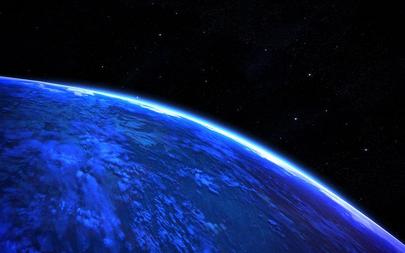
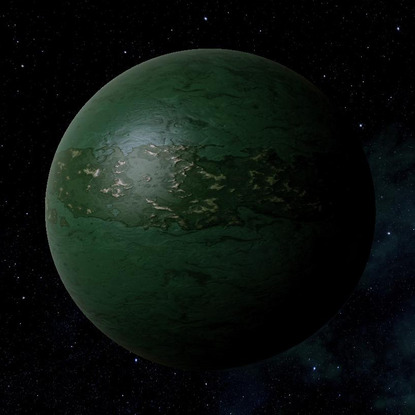
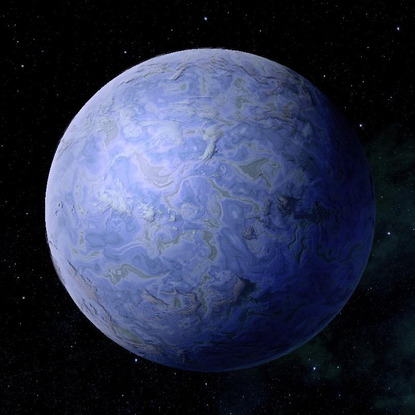
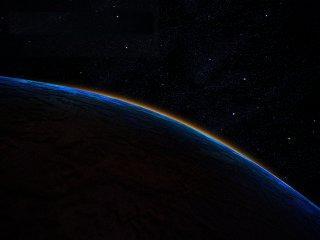
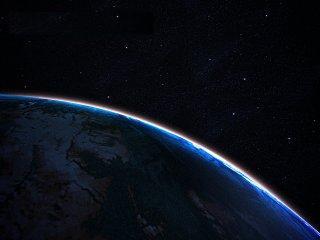
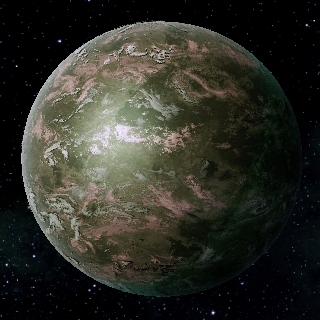
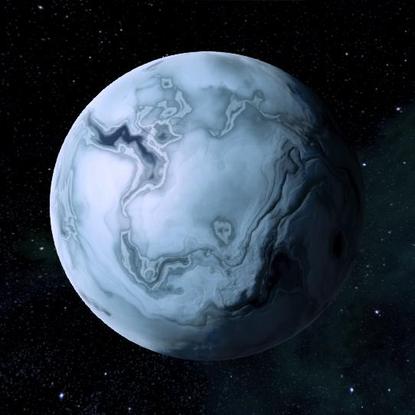
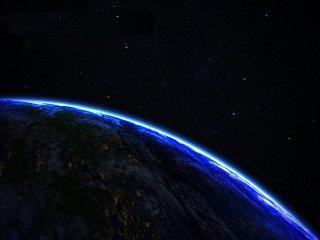
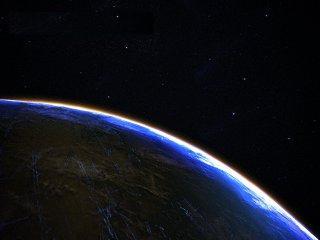
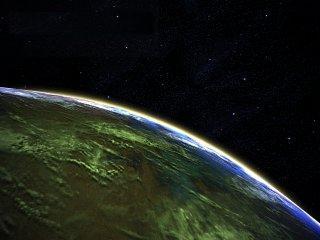
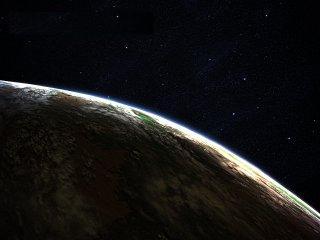
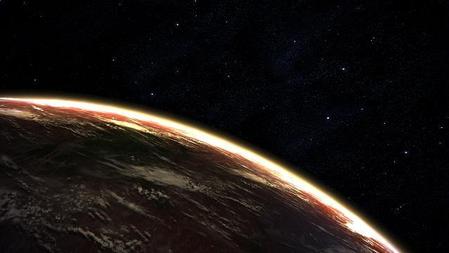
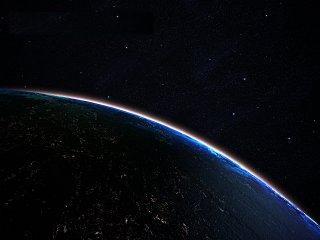
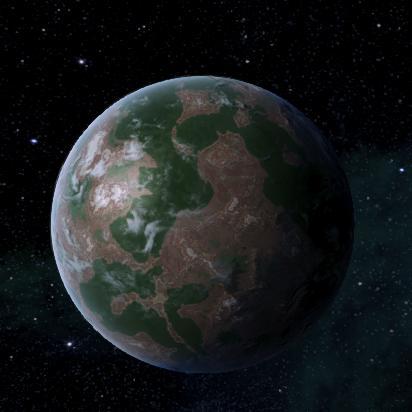

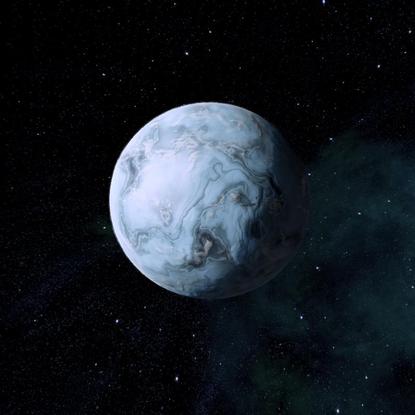
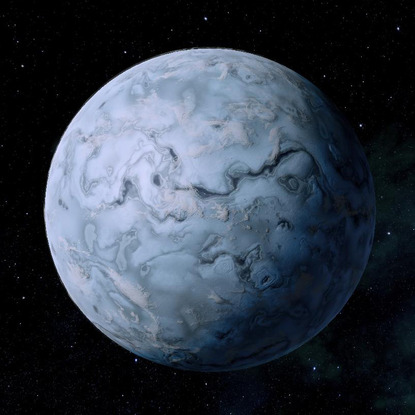
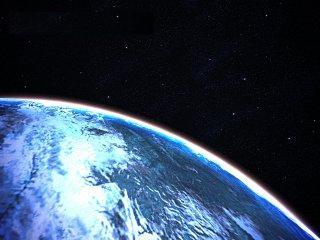
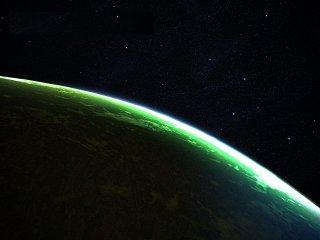
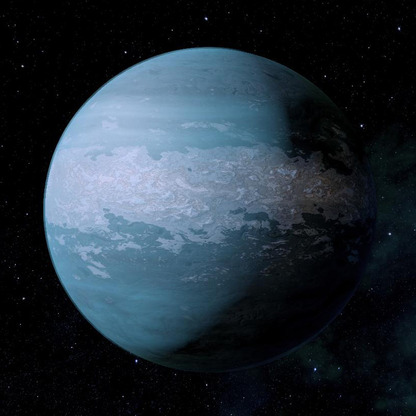
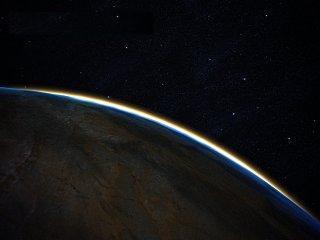
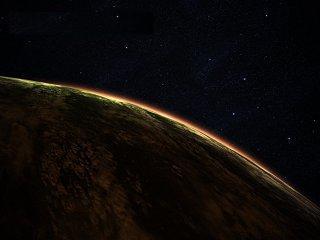
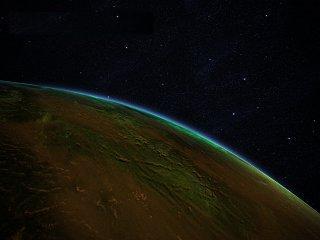
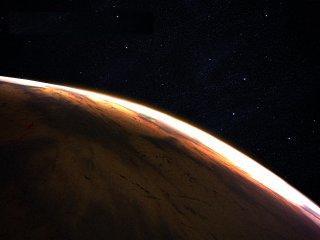
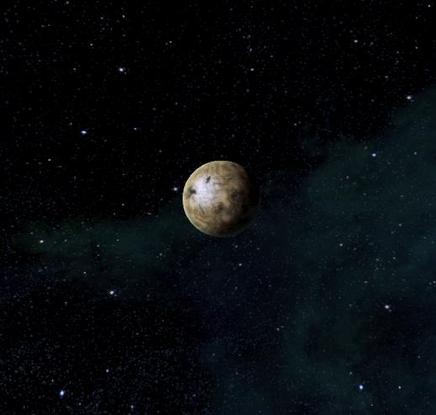
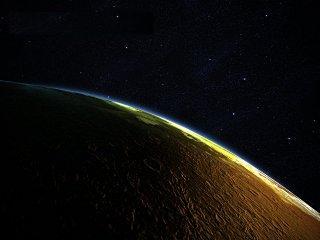
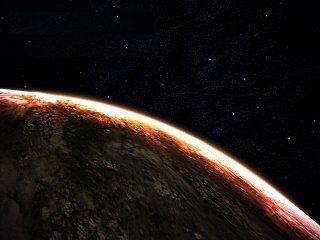
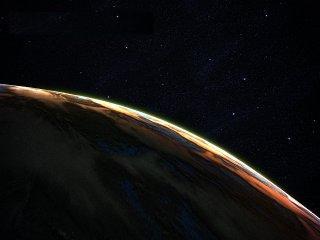
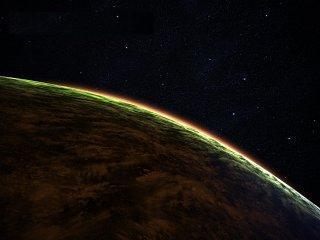
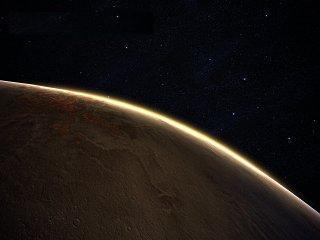
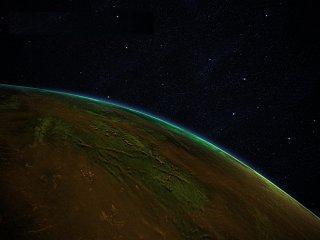
---[Temperature Brackets]---
The ranges of temperatures for each climate region of these Inisfreean worlds is limited to a 30 degree fluctuation because of their absence of axial tilt, their HAARP-regulated weather patterns, their perfectly circular solar orbits, and their generally very unremarkable topographies. The reason temperatures shift up and down by those 30 degrees at any point upon their surfaces is due to altitude, cloud cover, wind chill, proximity to flowing water, and the day-night cycle. As one moves closer to the equator of any of these worlds, this 30-degree temperature range will naturally raise, and as one moves closer to the poles of any of these Inisfreean worlds, that same range will naturally lower (a 100 degree difference from pole to equator, such that the range will shift from, for example, [0 to -30] at either polar region, to [100 to 70] in the equatorial region).
The ranges of temperatures for each climate region of these Inisfreean worlds is limited to a 30 degree fluctuation because of their absence of axial tilt, their HAARP-regulated weather patterns, their perfectly circular solar orbits, and their generally very unremarkable topographies. The reason temperatures shift up and down by those 30 degrees at any point upon their surfaces is due to altitude, cloud cover, wind chill, proximity to flowing water, and the day-night cycle. As one moves closer to the equator of any of these worlds, this 30-degree temperature range will naturally raise, and as one moves closer to the poles of any of these Inisfreean worlds, that same range will naturally lower (a 100 degree difference from pole to equator, such that the range will shift from, for example, [0 to -30] at either polar region, to [100 to 70] in the equatorial region).
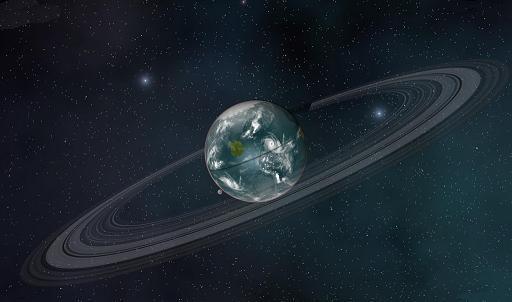
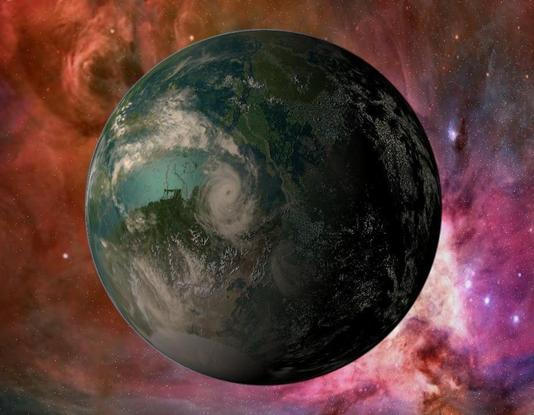
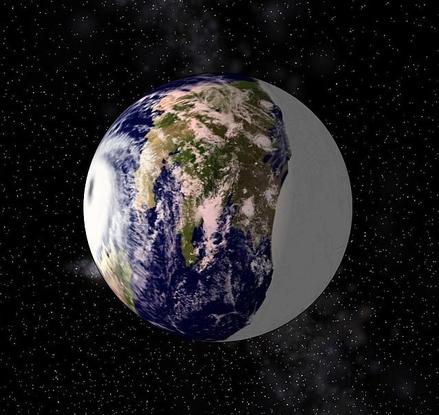
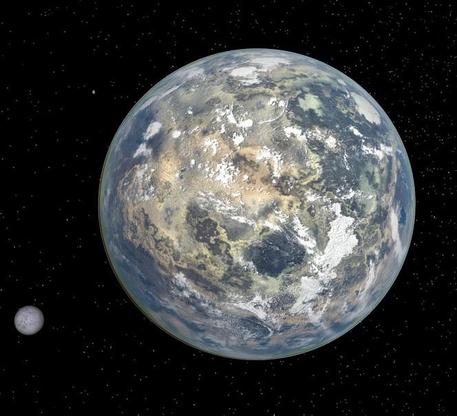
Note: Days on All Star-interior Worlds
Being inside the nebula in the core of system Auzdein's main star, both poles experience 'days' as the 'circle of sunlight' (one of the holes in the nebula allowing the main star's light to shine in) being fixed like Earth's North Star (Polaris). The farther one is away from this planet's poles, the more this 'circle of sunlight' (hole in the nebula) seems to move in a ring above them. At the equator, neither of these 'lights' are visible; it is an equatorial band of eternal dusk, with twilight at the equivalent of Earth's 'tropics'.
Being inside the nebula in the core of system Auzdein's main star, both poles experience 'days' as the 'circle of sunlight' (one of the holes in the nebula allowing the main star's light to shine in) being fixed like Earth's North Star (Polaris). The farther one is away from this planet's poles, the more this 'circle of sunlight' (hole in the nebula) seems to move in a ring above them. At the equator, neither of these 'lights' are visible; it is an equatorial band of eternal dusk, with twilight at the equivalent of Earth's 'tropics'.
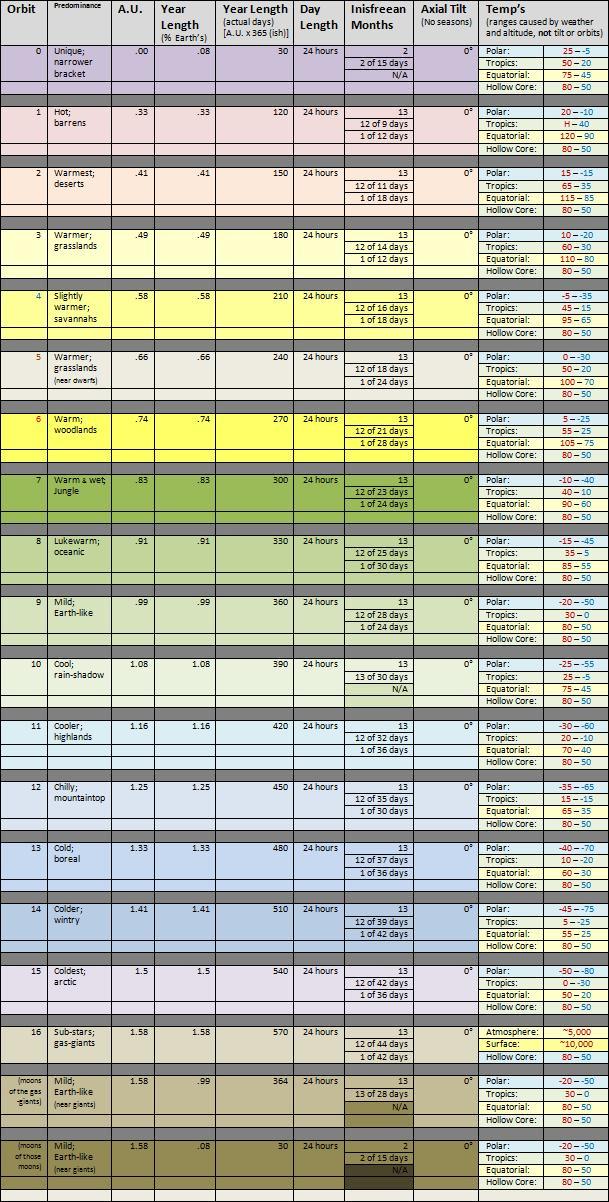
---[Nightlife]---
Nowhere in the entire Verse will you find a better, more amazing, more jawdroppingly sexual, sensual, erotic, exotic, top shelf, high end, ‘spared no expense’ nightclub, dirty-dancing, rave, house-music, and free-love scene than on the planets and moons built by the Inisfreeans. ‘Off the hook’, ‘unbelievable’, ‘godlike’, ‘out of this world’, and ‘too good to be true’ don’t even begin to describe the perfection that is this supremely clever, classy, sophisticated, and high-tech party environment, atmosphere, philosophy, and society. The Inisfreeans put Ibiza and Abercrombie to shame, exceeding all their concepts and works by leaps and bounds –as well as lightyears! Imagine dance clubs as sexy as an A&F retail outlet in the richest city, but on the scale of a stadium, yet also built with the most valuable and flashy gemstones and silken fabrics ever dreamt of by anyone across the Cosmos. You’ll just have to experience it for yourself, as no language could ever hope to quantify or express it all (save, perhaps, the Inisfreean’s techno-pathic, omni-sensory language of shared life events and full-bodied sensations). If you’re lucky enough to meet an Inisfreean exploring their Outlands (the realm of Creation outside their empire of Inisfree-city and star-system Auzdein), respectfully ask them for a tour of their heavenly, hidden realm! You’ll be glad you did.
Nowhere in the entire Verse will you find a better, more amazing, more jawdroppingly sexual, sensual, erotic, exotic, top shelf, high end, ‘spared no expense’ nightclub, dirty-dancing, rave, house-music, and free-love scene than on the planets and moons built by the Inisfreeans. ‘Off the hook’, ‘unbelievable’, ‘godlike’, ‘out of this world’, and ‘too good to be true’ don’t even begin to describe the perfection that is this supremely clever, classy, sophisticated, and high-tech party environment, atmosphere, philosophy, and society. The Inisfreeans put Ibiza and Abercrombie to shame, exceeding all their concepts and works by leaps and bounds –as well as lightyears! Imagine dance clubs as sexy as an A&F retail outlet in the richest city, but on the scale of a stadium, yet also built with the most valuable and flashy gemstones and silken fabrics ever dreamt of by anyone across the Cosmos. You’ll just have to experience it for yourself, as no language could ever hope to quantify or express it all (save, perhaps, the Inisfreean’s techno-pathic, omni-sensory language of shared life events and full-bodied sensations). If you’re lucky enough to meet an Inisfreean exploring their Outlands (the realm of Creation outside their empire of Inisfree-city and star-system Auzdein), respectfully ask them for a tour of their heavenly, hidden realm! You’ll be glad you did.
---[Elaboration: Demographics, Nomenclature & Urban Geography]--
Here is a detailed breakdown to help you better understand each of these world's populations and civilizations: [Portal]
Here is a detailed breakdown to help you better understand each of these world's populations and civilizations: [Portal]